#the climate crisis is very visible here
Text
february is usually the coldest month of the year around here, and the one we are most likely to get snow... but it's been relatively warm. Like spring weather. And not even a wet, rainy spring like what's normal around here. It's been somewhat dry and even sunny.
February, the deepest winter month of the year, is a dry spring....
#it's honestly so worrying#every year it gets dried and hotter in the pnw and the summer become more intense and longer#the climate crisis is very visible here#and i hate it#it feels like something is being taken away from me and there is nowhere i can go to try replacing it#whenever it does rain i like pretending that nothing is wrong and i was overexaggerating#but i know that's not true.#because the rain DOES come less and less often and lasts for less and less time and is of less and less intensity#climate crisis#pnw#pacific northwest#enviroment#environmental issues#climate change
5 notes
·
View notes
Text
Amazonian Whodunnit
Humanity is to blame for the slow death of the rainforest, but we are not equally responsible. The fingerprints of carbon inequality are all over this crime scene
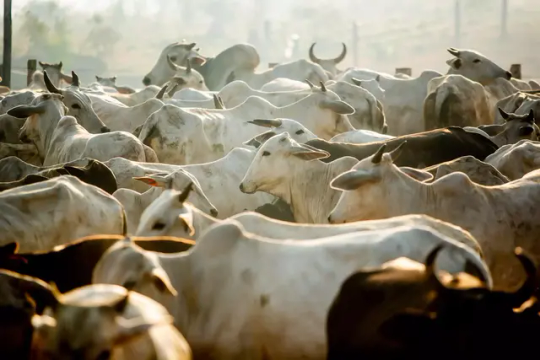
Every morning, I take my dogs for a walk to the scene of multiple crimes, where I grieve for the victims and consider who is to blame.
The location is the bank of the Xingu River, which is a five-minute stroll from my home. I will post a picture here of this beautiful but brutalised panorama so you can examine for yourself the violence that has been inflicted on the landscape in the nine years since I first visited Altamira.
The first victim, very stark in the foreground, is a dead tree, one of the many millions killed when the reservoir of the Belo Monte hydroelectric dam flooded the river banks, drowning countless plants and other species unable to flee the rising waters.
The second can be seen on the distant hillside on the far side of the river, where there are two broad expanses of cleared land that were cut out of the forest by neighbouring farmers who wanted more space for their cattle to graze.
The third is the sky, shrouded in an acrid haze from the dozen or so fires that were burning around Altamira over the 24 hours before my walk, according to NASA’s satellite imagery.
Fourthly – and most alarming of all – is the river Xingu itself, which has shrunk back to levels not seen in recent memory as a result of a freakishly long, hot dry season. Compared to the peak of the rainy season, the depth of the river has fallen by four or five metres.
The place where I usually swim is now a mud flat. Rocky outcrops have become visible mid-stream, creating dozens of new islands and adding to the challenge of navigation.The impact on other species is immeasurable.
That such horrors would come to pass was all too predictable. Earlier this year, I wrote that the El Niño on top of the climate crisis would create an emergency within an emergency, which Brazil’s authorities needed to prepare for as this would almost certainly mean a severe drought for the Amazon.
But there has been zero preparation. Across the Amazon, fire fighting units have been over-stretched and transport systems disrupted by the severity of the prolonged drought. Meanwhile land grabbers make things worse by starting fires to clear forest, taking advantage of the tinder dry conditions.
Those blazes cause problems long after the embers are dimmed. Countless studies have shown tree clearance has a local, regional and global warming effect, in addition to weakening the rainfall-generating capacity of the rainforest. Replace the trees with cows, as is the common practice in Altamira and much of the Amazon, and the effect is far worse because the methane burps and farts of the cattle are a more potent greenhouse gas than carbon dioxide. One of the most shocking reports of the past year was a study showing Brazil’s 220 million cows (almost half of which are in the Amazon) have a bigger climate footprint, when you include their role in deforestation, than all the factories, cars, power plants and 125 million people of Japan.
This brings us to the vitally important question for justice and for solutions: who is to blame?
There are those who would argue that humanity as a whole is responsible for this horrendous year of murderous heat, deadly fires, devastating floods and other global climate calamities, but that is only partly true. Yes, these extremes have undoubtedly been made worse by human burning of fossil fuels. The world is around 1.3C hotter than it was at the start of the industrial revolution. There is growing evidence that this makes El Niño events more likely. Yet despite the ever increasing death toll for all species from this heat, humankind is emitting more warming greenhouse gases than ever.
But “we” are not equally to blame. Not by any means. There is a huge carbon divide between the air-conditioned super-rich, who travel the world in luxury yachts, and the heat-vulnerable poor, who suffer the worst climate consequences even though they are least responsible. A new study by Oxfam and the Stockholm Environment Institute highlights the enormity of this gulf and its consequences.
Continue reading.
#brazil#brazilian politics#politics#environmentalism#environmental justice#amazon rainforest#mod nise da silveira#image description in alt
11 notes
·
View notes
Text
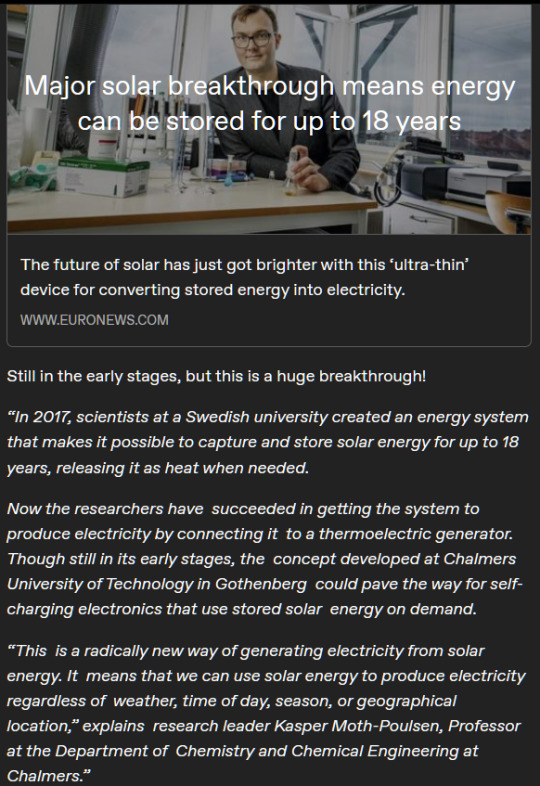
So I saw this on my dash and I had to dig a few articles deep to actually get an explanation of what’s going on.** Solar energy generation, storage, and conversion is something I’ve been studying since about 2015 as a researcher, so I’m always really curious what’s actually new about these articles.
Since even before my time, our field has been pretty adamant that the most important problem we face to a green energy future is how do we store our green energy. We can make tons of it! In fact, TOO MUCH for us to use. We just have no way of storing and delivering it once we’ve made it. People have been working on batteries (solid-state, redox flow...), chemical energy storage (use sunlight to make a chemical reaction that produces a fuel like hydrogen gas, petroleum, methane...), and many other ways to store solar energy for decades and decades.
Besides the fact this is just like, what I do for a job and enjoy thinking about it, figuring out what actual tech is being lauded as Good News was important to me. I (and you) need to know whether this is revolutionary phenomenal more hope for the future kind of good news, or if it was oh hey, this thing we’ve been working on for 20-30 years is finally reaching an almost-market-ready stage (and TLDR: it’s the latter).
So what makes this one newsworthy?
The device developed at Chalmers* is a form of chemical energy storage. Instead of making a fuel to use and burn, the chemical they shine light on purely stores energy, and releases energy. They have recently managed to package it into a neat little chip that takes sunlight, stores it, and then on-demand returns it as electricity that we can use.
-:-
The chemical they’ve used on this chip can exist in two differently shaped forms. And it can change between those forms with a little bit of energy. The researchers determined that the energy requirements for that transformation is small enough that sunlight can perform it.

So they shine light on one form of the molecule and it turns into the other; it takes the solar energy and “stores” it by resting in that new shape. It’s happy to sit there until they tell it to go back.
When it goes back, it “returns” the initial energy by giving away heat.
They’ve been able to turn heat into electricity somewhat efficiently.
The limitations of this kind of device are:
How much energy you can store is dependent on how many molecules you have on your chip (or in your tub, if you’re doing it in liquid form).
How efficiently you can turn that heat into electricity is a developing technology and they have room to go.
This specific set up requires an *additional chemical*, a catalyst (unsung heroes in most of the press) to help turn the transformed molecule BACK into its original form, the important step to deliver energy back to us! Cobalt(II) phthalocyanine is a known catalyst for these kinds of things and has its own drawbacks.
Doing this in liquid form currently requires organic solvents (in everything in life, we want to use water instead of organic solvents, if possible).
What % of the sun’s light is actually DOING this transformation limits how many of your molecules are actually going to change their shape.While yes, these chemicals do perform this transformation under solar light, specifically they require UV-light. There’s not *actually* a lot of UV light *in* sunlight; ideally, you’d want something that works in visible light (about 40% of sunlight is visible; about 5% is UV). (This is also a major limitation of many other solar technologies.)
Why am I explaining all of this?
I think it’s important for non scientists, particularly those who care about the climate crisis, to have this context. This technology is not a one-off moonshot; this technology is not our best hope; this technology is not the Answer to all our problems; this technology is not unique. The concept itself is also not new. It is not even “in its early stages” as far as research goes. This is a fairly well-developed device and system they are publicizing. It IS in its early stages of implementation.
This is the pace of science. And that should actually give you hope.
It means that for every one individual piece of news you hear like this, there are hundreds of different technologies also being developed, also being worked on, also close to implementation, too. People have been working on these problems, caring about these problems, UNDERSTANDING these problems, for decades even before the public ever caught up. There is progress being made and hope to be had, and nihilism about the climate, about whether The Big Feds and Corporations Are Paying Attention, is both inaccurate and counterproductive.
It IS exciting that this one is working to the degree it is. It IS going to be a useful tool in adapting to our energy needs and making a green future possible. And to me, as someone who’s been watching this field, it’s really exciting and satisfying to know that hey, all this hard work we’ve done uncovering the different pieces of this puzzle..? we’re starting to actually PUT THE PIECES TOGETHER in a functioning way now.
Sometimes even as a scientist, even as someone who understands the pace of research, it can be hard to feel like there’s ever going to be the point where things start working. We’ve been pursuing photoisomerization as energy storage for ages and ages, but it’s never been efficient enough, or we’ve never had a way to release the energy once it’s been stored, or all these other problems. But we’re finally at a point where grit, determination, persistence, and hope, have gotten us through the worst of those issues and gotten some solid footing. And that’s really exciting
-:-:-
*(woo, Gothenberg, they are a hub of green energy development and a bunch of my friends work there. some of them have even worked on related projects as visiting researchers over the years)
**You know what’s really personally annoying about this blurb on tumblr and the euronews article itself??? I had no clue from either of them that I HAVE ACTUALLY REPORTED ON THIS, PROFESSIONALLY. They didn’t link back to a Chalmers press release, or to the researcher’s group websites, or to the papers, in an obvious or accessible way. One of the scripts I worked on last month was literally about this paper and I had to help one of our writers explain what photoisomerization is and thermal electricity generation. It took way too much digging to realize that.
I should have been able to understand from reading this blurb and especially from reading the press release what this actual development WAS.
Good popular-science / general public articles should convey to both non scientists and scientists what the actual technology/research finding is, from the get-go. Anyway, that’s a pet peeve of mine with science communication and with these “hopey fluffy happy science” blogfeeds. You can do better, without descending into the nitty gritty like I did in this longform tumblr post. (And we did, for our show.)
#full shade#the press release that was linked on my dash sucks#basic scicomm principles cmonnnn#climate change#green energy#personal#long post#i am a phd chemist researching photocatalysts#i have worked for esteemed science journalism outlets#i have a chemical engineering and materials science and nanotechnology background#there are my creds lol
73 notes
·
View notes
Text
next up in fragments from the goggle docs: a fic with the working title "the best kind of v-day gift is a dildo in the ass", feat: wonka/oc couple being middle-aged and willy having a crisis about it.
It was a point of pride for Willy Wonka that nothing created within his factory was artificial.
Now, that might sound like a hefty claim for a man who crafted ice cream that never melted no matter how long you left it out in the sun, or chewing gum that could turn a little girl into a gigantic blueberry, or any other of the endless wonders that had come out of that factory over the years. But to Willy Wonka, the word ‘artificial’ was practically a curse; it called to mind noxious chemicals, toxic E-numbers, and that whole parlava a few years back over blue skittles.
No, nothing in his factory was artificial… he just had a different way of looking at what the Earth gave him naturally, and did some very interesting things with that bounty -- and if nobody else was smart enough to give Mother Nature a nudge here and there to synthesise a snozzberry, or breed sheep that grew cotton candy straight out of their backs, well, there was a reason he was the undisputed King of Candy and not those idiots over at Hershey’s or Nestle.
The trouble with that line of thinking was that a genius could be extraordinarily smart in one respect, and incredibly foolish in others; deeply susceptible to a colossal hubris that took to wondering -- if he could bend the laws of nature to his will where candy was concerned, then why not try… other… applications?
----
Light came slowly in the mornings; a gentle glow emanating from the lamps dotted around the factory to mimic the sunlight that rarely if ever penetrated the thick concrete walls. Colours spilling from the darkest twilight shades steadily brightening through scarlet, mauve, amber, and finally pale yellow, all gleaming through gossamer-fine hangings spangled with gold and silver embroidery, onto an enormous bed. Piles of cushions and coverlets were heaped upon it; velvet, satin, silk, Egyptian cotton, all in wanton, boudoir shades of scarlet and burgundy and royal purple, accented with flashes of black and ivory.
Finally, within this wonderland, the light illuminated two bodies entwined in sleep.
Conventional folk wisdom held that married couples grew, over time, to look alike, but the resemblances here were scant. One was fair-haired, with a cavalcade of blonde curls spilling over the pillows, the covers thrown back to reveal a skimpy black negligee, and a mouth still half-bloody with last night’s lipstick. Another flush of red bloomed on her chest. Madeleine found the climate of the factory hard to bear in recent years, although it was difficult to say who was the greater martyr: Madeleine herself for suffering the hot flushes of middle age, or her husband for the way he often found himself sharing a bed with a burning hot engine in human form.
Said long-suffering husband sported a bob of dark hair that flowed like melted chocolate over his cheek. Unlike his partner, he nestled comfortably into the covers (at least for now), but a flash of scarlet pyjamas was still visible. His eyes were ringed with a mixture of shadow and mascara, smudged where he had pawed at his face in sleep.
Actually, there was one similarity: both of them had hair streaked with grey, faces lined with joys and sorrows; signs of lives lived fully and well.
Last night was lived particularly full and well, at that. Charlie’s 21st birthday necessitated a full throttle bacchanalia in two parts: dinner for the family (crowned with a magnificent triple chocolate birthday cake crafted jointly by Willy and Madeleine), followed by a party hosted at Rapture. Given the occasion, and the fact that the elder Buckets had bowed out after the dinner, the night had gotten… rather wild.
Which was why, as the brightening room stirred them from sleep, they groaned in unison at their throbbing headaches.
Madeleine was the first to stir properly, cursing under her breath and rubbing her temples with a grimace. Once she regained her sense of place, she groped towards the bedside table for the glass of water she’d retained just enough foresight the night before to place there. Levering herself up was a heroic exercise, rewarded by slightly stale, room-temperature water: in that moment, perhaps one of the most delicious things she had ever tasted.
“Are we dead?” Willy moaned only half-coherently, face buried into a lacy pillow, in his usual dramatic fashion.
“I think if we were dead our heads wouldn’t hurt so much,” Madeleine replied. Even with the water, her voice rasped; her tongue was inclined to stick to the roof of her mouth. “Drink your water.”
“I don’t have any water.”
“Yes, you do, I put a glass next to the bed for you last night.”
“You -- oh!” Willy raised his head far enough to spot his prize. “I love you, Maddy.”
Madeleine chuckled, reaching out with her free hand to ruffle Willy’s hair affectionately; her laughter only grew when he whined and ducked away like he always did. Even with bedhead, Willy was always conscious of his appearance.
“I love you, too. Did you have a good enough time last night to justify the hangover?”
“Ugh… ask me again after I’ve had a mocha and something to eat, I’ll give you a fairer answer.”
As if on cue, a polite knock at the bedroom door announced Sidonie arriving with the breakfast trolley. Normally, Madeleine made breakfast for them herself, but after late nights she gratefully handed over the task of feeding them to the expert. Sidonie was by now an old hand at hangover breakfasts and had a rotation of menus that perfectly balanced the necessary starch to soak up the lingering alcohol with the nutrition needed to kick start two middle-aged bodies back into gear.
Sidonie also had a knack -- much appreciated by her employers -- for managing to disappear within moments after delivering breakfast, sparing everyone the embarrassment of Willy and Madeleine appearing deshabille post-debauchery. Madeleine clawed her way out of bed, cracked the door open to confirm Sidonie had vanished, and then opened it further to pull the breakfast trolley inside.
A pot of hot chocolate: brewed strong, dark, and with a kick of chilli. A platter of french toast, another of scrambled egg and bacon, and a third with an artistic display of cut fruit. Madeleine and Willy inhaled gratefully, pouring cups of chocolate, fixing their plates, and then returning gratefully to bed with their bounty.
Breakfast came along with the morning post: a package for Madeleine and a stack of letters and newspapers for Willy. The former were business; the latter, despite Willy’s protestations to the contrary, were pure pleasure. Or perhaps it was more accurate to say they were pure vanity. The world’s greatest chocolatier liked nothing better than to bask in evidence of his own superiority, and hoarded all mentions of himself in print like a smug, self-satisfied dragon. He perused the papers every morning over breakfast, preening over the compliments and swearing violent, bloody vengeance on any journalist who dared to criticise him.
(Nor were these threats in any way idle: the still-unsolved mystery of Arthur Slugworth’s disappearance was testament to that. Ahh, good times… Making Slugworth pay for all he had done was one of Madeleine’s most cherished memories, and she was so glad she’d convinced Willy to let her salt him like the slug he was.)
Of course, Willy had extremely good cause to be smug and self-satisfied. Plus, Charlie collected the clippings off him to continue the scrapbooks Dr Wonka had left behind when a heart attack finally carried him off five years earlier. Madeleine was quite sure that Willy valued the scrapbooks more than the scant handful of pleasant memories he had with his father as a grown man, and she didn’t blame him.
Willy flicked through the papers, letting out a contented hum as he scanned the usual headlines praising Wonka Candies: they had released a new range of patisserie-themed chocolates earlier that week and they were receiving every bit of adulation they were due. Until, suddenly, he paused on a particular tabloid, blinked several times, and then emitted an ungodly shriek of indignation.
“RETIREMENT?!”
Madeleine, jumping in shock, cursed as her hot chocolate slopped onto the bedcovers. She grabbed a napkin and mopped the mess up as best she could, but distractedly: her focus was on her husband.
“What? What about retirement?”
“This!” Willy hissed, shoving the tabloid in her face, one finger stabbing at the headline. “They--they--they’re saying -- they think I -- and I don’t look like that, do I, Maddy?” he finished with a wail.
“Willy--” Admitting defeat with the coverlet, Madeleine dropped the sodden tissue onto her breakfast tray, set down her half-empty mug, and took the newspaper from him. “What is this?”
“They’re saying I’m old and ugly and I should go away!”
The article in question was not quite so blunt… but it wasn’t far off, either.
CANDY KING GOING STALE
IS WONKA READY FOR RETIREMENT?
For more than thirty years, Willy Wonka (52) has ruled the confectionery world, an enduring fashion as well as culinary icon, seemingly as impervious to the years as his infamous never-melting chocolate ice cream. After seeing photographs taken outside Rapture, the bar owned by longtime partner Madeleine Berry (52), however, it looks like the King of Chocolate is finally reaching his limit.
Was this just a rough night, or is there a reason why Willy Wonka spent most of his youth out of the public eye -- the better to sustain his apparently fragile image? Rumours have abounded for years that Wonka has chemical support in maintaining his electric personality and unyielding domination of Candyland, although he has always denied the allegations even after Berry entered rehab in 1990 and again in 2009.
Perhaps all candy lovers should be grateful that Wonka’s protege is ready to step into his increasingly unsteady shoes…
Story continues on page 5.
The photograph in question was indeed singularly unflattering: snapped at an angle, slightly blurred, it showed Willy stumbling on his way out of Rapture and leaning on Charlie’s shoulder for support. Bright fluorescent lighting from the streetlamp overhead mixed poorly with the coloured neon glare from Rapture’s sign, making Willy look more gaunt and washed-out than usual.
It had been such a brief, silly moment that Madeleine had forgotten about it: they were all drunk (they were celebrating Charlie’s 21st, for God’s sake, they were hardly likely to make it through the night sober), but not to the point of incapacity. Willy stumbled due to a loose paving stone on the street outside after they finally called it a night. Hell, Madeleine had already asked Robbie to hassle the council and get it sorted a few days earlier, but even the power and wealth of the greatest confectionery business on Earth was not enough to kick local authority bureaucracy into high gear.
Looking at the photograph out of context, however, it did look as if Willy was either frail, off his head, or both… and God forbid a sleazy tabloid pass up the opportunity to fling mud at a celebrity.
At least Slugworth was eight years in the ground, Madeleine reflected with grim satisfaction, or else the so-called journalist responsible for this would no doubt have gotten a gloating statement out of him. She was almost surprised they hadn’t dug up his corpse to interview it.
“Bloody paparazzi.” Madeleine sighed and folded the newspaper in half, hiding the offending article. “Don’t pay any attention to it, darling, you know what those bottom-feeders are like.”
But Willy was not so easily comforted. He hunched in on himself, turning a brooding stare into the depths of his hot chocolate, and ignoring the remaining papers.
“I mean it, Willy,” Madeleine continued, her tone softening from its previous briskness. She reached out, laying a hand on her husband’s thin shoulder. “They took a bad shot, which says far more about the photographer than you, and they’re trying to pass it off as if it means something, but it doesn’t. And anyone of any sense will see that, too.”
Willy just let out a low hum, which might have been agreement, or simply indicating a desire to move on. He was silent through the rest of breakfast, picking at his food or ignoring it entirely even when Madeleine tried to cajole him into eating. Madeleine was still finishing her french toast when he slipped out of bed and disappeared into his bathroom leaving only an indistinguishable mutter in his wake.
The satisfaction Madeleine got from tearing out the offending tabloid pages and ripping them systematically to shreds was paltry, but that didn’t stop her from doing it.
----
When they drew up the plans for the factory all those years ago, Madeleine knew the builders and architects thought the choice of his-and-hers bathrooms was at her insistence… Which it was, but not for the reasons they assumed. Having lived with Willy in that cramped apartment above the Cherry Street shop for five years at that point, Madeleine knew that the love of her life was a bathroom hog on par with the greatest Old Hollywood divas. If Madeleine ever wanted to start the day on time and looking her best, they needed separate spaces. Dear God, even she didn’t spend as long in front of her makeup mirror as Willy did!
“Willy?” Madeleine called as she knocked on the locked door of Willy’s bathroom. “Are you alive in there, or did you drown in the shower?”
Unease simmered beneath the jibe. Madeleine was normally the one who reverted to self-isolation when unhappy, while Willy was more likely to act out, pouting and whining and throwing a tantrum. For him to lock himself away meant this was more than mere unhappiness or passing embarrassment at an unflattering picture. Of course Madeleine knew how sensitive Willy was about the image he projected to the world, but for one photograph to have this impact was… troubling. It made her wonder exactly what nerve the photograph had touched, and how deeply the pain went.
Like toothache, she reflected -- ruefully, because she knew how much Willy would despise the comparison, but here it was apt. Pain flared up, but was it just a passing twinge, or a sign of a building rot that had so far gone unnoticed?
“Come on out, love. Tell me what’s going on in that head of yours.”
No reply from within the bathroom. Madeleine was just about to knock again when the door opened and out stepped a figure that made her breath catch in her throat; she actually took a half-step back in shock.
“...Willy?”
Willy had transformed himself. His hair was a sleek, uniform chocolate brown with not a single grey hair to be seen. His skin was smooth and even and utterly flawless; no crow’s feet at the corners of his eyes, no smile lines around his mouth, no dark circles from their late night. He was dressed only in his silky robe, but Madeleine was sure it was cinched tighter around his waist than it had been earlier, and the flash of chest above the burgundy silk looked… firmer.
As Madeleine dragged her gaze back up to her husband’s face, she was met by a grin. Not just any grin: wide, wild, and a little manic. It was the absolute perfect example of Willy’s cat-got-the-cream smile, the smile that meant he was up to mischief, which meant this was more than her initial assumption of hair dye, foundation, and a couple of vitamin shots.
“Hi!” he cooed, striking a pose. In that second he looked nineteen again, happy as a lark after Madeleine lent him a dress and made him up for the first time. As if he was finally comfortable in his own skin. “What do you think?”
“You… You look…” Madeleine struggled to find the right word. Amazing leapt to mind, as did fabulous and gorgeous and all the other superlatives that aptly described a beautiful young man, but… Willy wasn’t a young man. He was fifty-two years old, and God she adored him, but he didn’t look like this. “...Different.”
“Oh, do I?” Willy patted his bob and batted his eyes. “In a good way?”
“What have you done?”
The smile on Willy’s face grew visibly forced. Madeleine could feel the pressure to bow to the narrative he was trying to craft in the air around her, squeezing her from all sides; not least from her own impulse, never quite erased, to make sure Willy was happy above all else.
“Can’t a girl just want to look her best?”
----
“You’ve got to try it, Maddy!” he finished, holding out the tiny pill with a flourish.
He looked so earnest, and so utterly certain, like a benevolent god holding out a miracle… and Madeleine recoiled from it; from him.
“I’ve got to?” she echoed. Her voice cracked halfway through the question as every single one of her fifty-two years suddenly bore down on her like lead weights; physically dragging down her flesh, hissing in her ear, every single one of the old insecurities rushing back to scream triumphantly that see, see, he never thought you were beautiful, you stupid bitch, you should have known he was just putting up with you, taking pity on you -- look at yourself, you haggard, ugly hag! Grey hair, wrinkles, sagging tits, sweating all the time with the hot flushes, you don’t even get as fucking wet as you used to, no wonder he wants you better, no wonder he wants you changed--
“W--well, I mean, don’t you want…?” But here Willy faltered. He looked her in the eye, and something desperate flashed across his own face, gone before she could categorise it, followed up with another wide smile. “You’ll feel so much better, Maddy, I promise! We both will! And then everything will be good again!”
“I thought we were pretty good already.” Madeleine crossed her arms defensively -- protectively -- across her chest, now excruciatingly aware of how the cut of her blouse highlighted the creping skin on her neck and how her breasts didn’t sit quite as high as they used to. “I didn’t realise me being an old hag was so offensive to you.”
----
Charlie sighed and pinched the bridge of his nose. “Right. Okay. I think I see what happened here. Willy, do you remember that time we talked about how there can be a… um, a gap, between what you say, and what someone else hears?”
“Uh-huh! That’s definitely what happened here,” Willy confirmed. “I said I’d found the most amazing way for Maddy and I -- and you, of course -- to look and feel perfect forever, and she heard some kooky nonsense about me not loving her any more! I just don’t know how to make her hear me properly.”
Charlie looked pained. Willy sympathised; it was never easy, running up against Madeleine’s spiky edges, where she wouldn’t hear a gosh-darned thing you said to her, and Charlie idolised her… Poor boy, he was probably realising now he was all grown up that sometimes idols weren’t infallible.
“Right… So maybe you -- we -- need to start by trying to understand Maddy’s point of view. I think she might be upset because it sounded like you aren’t happy with how she looks now.”
----
Chestnut hair streaked with strands of grey. A porcelain face carved with lines of both worry and laughter. Hands as delicate as scientific instruments, still pristine from age spots due to his habit of wearing gloves, but gloves could not preserve his skin perfectly from growing thinner, or stop veins standing out more visibly. A body softening from its previous youthful firmness.
And every single inch as perfect and beautiful and alluring as the day she first set eyes on him.
"Oh, stuff and nonsense!" he protested when she first voiced as much. Body twisting, looking away, cheeks aflame with colour. "Maddy, I… I know I'm not -- well -- what I used to be."
"That's enough of that," replied Madeleine, implacable as iron. "Nobody gets to say you aren't beautiful, least of all you yourself. Look at you, sweetheart… The most gorgeous girl I've ever seen, even now. Especially now."
"Especially how?" Willy demanded; not wooed, not yet, but betraying a willingness to be.
Madeleine capitalised by pulling him close and pressing a firm kiss to his pouting lips.
“So getting older makes you ugly?” she asked in a low voice. “Does that mean I ought to get rid of all that lingerie? If it’s going to waste on an old bird like me.”
How far they had come, that she could voice such an idea with nothing more than irony in her tone; that the idea she was hitting on a secret truth did not even cross her mind. Willy widened his eyes and instantly squawked a denial.
“No! No, no, you -- Maddy, you’re gorgeous!”
“Really?” Madeleine lowered her eyes, affecting uncertainty. “Even though I’m not as firm and tight as I used to be? And all this grey in my hair… it doesn’t exactly set off the leather--”
“No!” Willy interrupted her firmly -- no, desperately. He cupped her jaw in his hands and tilted her head up to kiss her. “No, no, no. That’s ridiculous, you’re beautiful -- just ‘cause you’re a little older doesn’t mean--” Abruptly, he stopped, leaned back, and narrowed his eyes at her; Madeleine smirked in response, and Willy huffed, throwing his hands up in the air. “Oh, gingersnaps, I hate it when you do that! Stop making me out to be a hypocrite if I don’t agree with you!”
Madeleine couldn’t help it: she laughed. “Well, stop spouting rubbish then, you silly boy!”
Willy huffed again, folding his arms across his chest. “You -- but -- that’s not--” Madeleine raised her eyebrows, wordlessly cutting off that line of protest, and Willy sighed. “Fine. So long as you promise not to get rid of the leather! Or the lingerie. Or anything else, ‘kay?”
“Oh, don’t worry,” Madeleine assured him, looping her arms around his waist to pull him close; he melted against her, belying his pretended irritation. “I happen to have some very important plans for all of those goodies.”
“Plans?” Pink suffused Willy’s cheeks as he looked up at her hopefully from where he was nestling his head against her shoulder. “Wh--what kinda plans? You know brainstorming is better with two, right?”
“Normally… But this happens to be a surprise.” Madeleine winked. “You know how good I am at those.”
“Huh.” Willy paused. Madeleine, sensing he wasn’t quite done, contented herself with nuzzling his hair as he percolated. “...You’re not just saying that because--”
“I’m saying it,” Madeleine interrupted him, knowing precisely where that was going, “Because you're gorgeous and I’m as mad for you now as I was at eighteen. Because every year you get more wicked and wild and wonderful than I ever thought you could." Madeleine chased kisses down his neck, smirking against his skin as he shuddered. "Lovely girl. You can't really think anyone could ever eclipse you? You're the most delicious creature I ever laid eyes on."
“Mmm… not that girly anymore,” Willy murmured, half under his breath.
Madeleine eyed him, surprised, but kept her voice carefully neutral as she asked, “You don’t want to be a girl anymore?”
“I’m not -- I’m--” Willy sat up, gesturing to himself, cheeks darkening. He laughed, though it was a hollow sound. “‘M just an old man now, Maddy.”
“You’ll be my girl until you’re ninety-five if that’s what you want.”
Madeleine spoke only the truth when she told Willy she loved him even more now than she had when they were young. Looking at him now, splayed out on the bed, pale and perfect in her eyes… The sight of him sent a sharp spike of desire through her core, leaving her breathless, in some ways even more so than when she was twenty. Now, his allure was as strong as ever, while the years had enhanced trust, dulled insecurity, and forged between them the certainty of commitment. Now, desire was the sugar of his skin on her tongue, without the bitterness of wondering if she was good enough for him. Now, she knew damn well there was nobody for either of them but each other.
----
As for that package she’d received the morning this all started…
Her intention had been to wait until Valentine’s Day, because she had a wildly romantic streak that she loved to indulge when the opportunity arose. Willy kept nagging at her, however, trying to weasel out her plans, which far from annoying Madeleine only made her more eager to get on with them, and in the end she only lasted until the end of the week before breaking out her costume and preparing their playroom.
Leather gloves. Cherry red satin lingerie. The high heels hadn’t been quite so high since her back started twinging in the morning, but she was taller than Willy anyway so it wasn’t the biggest loss. Otherwise, the routine was as familiar as breathing by now, and in this case familiarity bred the complete opposite of contempt.
“Kneel,” she ordered, and Willy obeyed promptly.
Nowadays they used a pillow for his knees -- memory foam was a glorious invention -- and Madeleine did not tie the bondage quite as tightly as she used to, out of respect for his joints. The blindfold still went on, though, and Willy’s mouth had only grown more devious over the years.
Speaking of which… Madeleine gasped, grabbing a handful of Willy’s hair as he made fabulous use of the opportunity afforded by her peekaboo knickers.
#fragments from the google docs#this one is the most fragmented so far i think#but it's been languishing for months and my brain can't connect the dots so fuck it#catcf 2005#willy wonka#wonka/oc#charlie bucket#on a scale of zero to ten on embracing your ageing body willy chose violence and wonka-vite
2 notes
·
View notes
Text
Prince Charles: The increasingly visible Invisible Contract
Lainey
POSTED BY LAINEY
ON 05/07/2022 AT 7:29 PM
Last year, during the Television Event of the Year, Prince Harry told Oprah Winfrey about the “invisible” contract which is the British royal family’s agreement with the UK tabloid media – a you scratch my back I’ll scratch yours relationship that’s basically an open secret except that no member of the family would ever admit to it… until, of course, the Firm made it so that Harry and Meghan have no more f-cks to give.
Celebrities often maintain close connections with members of the media, this is not news. But the thing about the British royals is that they don’t consider themselves celebrities. They look down on celebrities. They think of themselves in a different class altogether, a much more elevated one. As IF they’d deign to get into bed with a tabloid, with the press. As if they would have to. Oh but they do.
But it’s not like those relationships are with the British equivalent of the New York Times or the New Yorker. No, we’re talking about The Sun and the Daily Mail, bottom-feeding publications that foment the worst in our culture, and the same publications that have been exposed for racist, sexist, and transphobic coverage – not past, but CURRENT. They’ve also been sued by the Sussexes and lost.
And now an editor for one of those publications has been recruited by Prince Charles and Camilla to run communications for Clarence House! Tobyn Andreae is the former deputy editor of the Daily Mail and is now the Prince of Wales’s communications secretary. The Invisible Contract has just become very visible.
Are you seriously telling me that the best communications candidate available to the FUTURE KING OF ENGLAND is someone who just came from the Daily f-cking Mail?!
Hiring someone who is still freshly wafting Daily Mail stink is a tacit endorsement of the work that they did while they were there. Like calling Meghan Markle “Straight Outta Compton”. And not taking climate change seriously which, FFS, is one of Charles’s priorities!!!!
Still, this is the direction in communications that Charles, Camilla, and Clarence House seem to be pursuing. And on that note, here’s Omid Scobie’s latest column on royal comms strategy:

Note this paragraph in particular – background information on a royal briefing that happened last week following all those headlines about Charles accepting shopping bags and briefcases full of cash while there’s already a cash for honours controversy swirling around his charities:
“… when the Prince of Wales was forced to announce via his spokesman that he will never again accept plastic bags filled with €500 notes for his charities, one of his senior aides also briefed journalists with adorable details of the heir’s first time meeting granddaughter Lilibet last month. (Yes, one of the same private family moments royal sources had “feared” the Sussexes would leak. The irony).
As Omid Scobie points out, all the coverage about Charles’s latest cash for honours f-ckup was buried by reports about him meeting Lilibet. So in the same briefing about the bags full of cash, Charles’s comms secretary dropped in a little nugget about Charles spending time with his youngest granddaughter. The implication here is that he used Harry and Meghan’s baby to deflect from his own alleged scandal. So the child is a convenient asset when he needs to change the story but he can’t defend the child’s parents when they’re being attacked by the media? OK.
There’s more – Omid Scobie again:
“It was a similar scenario when the Royal Household revealed last week that, while Britain continues to struggle with a devastating cost-of-living crisis, the Royal Family has spent more money than ever. The latest Sovereign Grant Report showed that in 2021-2022 the royals cost taxpayers £102.4 million ($122.9 million)—17% more than the previous year — and their travel costs had rocketed from £1.3m ($1.5m) to £4.5m ($5.4m).
Outrage over spending, including the £100,000 ($120,000) spent on just three royal train trips, made its way across more serious media outlets, but the news failed to make the front pages of the country’s most-read tabloids. Instead, their headlines focused on something else - a suspiciously timed update on the investigation into bullying claims against the Duchess of Sussex.”
Coincidence or conspiracy?
Tobyn Andreae hasn’t even officially joined Clarence House yet. Imagine how much dirtier it will get?
&Omids article:
#royals#brf#omid scobie#lainey gossip#abolish the monarchy#prince charles#daily fail#british royal family#invisible contract
13 notes
·
View notes
Text
Hey :) so i just typed a little essay for my book blog but it really...wasn't about the book I was reading at all so honestly I'm just gonna repost it by itself here since I have more followers here and I dont know i just need to get this out :)
Okay here we go, this post took a while to write because I needed to be angry enough at the current climate around LGBT issues in America and now unfortunately seems to be the perfect timing. I am going to put my thoughts under the cut because it's going to be very triggering including discussions of
transphobia/transmisogyny, hate crimes, homophobia, childhood sexual abuse and grooming, mentions of fascism
To start off with, at the time of writing on July 24th, monkey pox has gone from something people were murmuring about mostly in LGBT communities to a declared global health crisis. At the same time, with monkey pox now an issue for the general public to officially worry about, the framing of monkey pox as an STI from gay sex has hit the mainstream. This is completely inaccurate, and while I would encourage you to research this more rather than just reading one post by some random person on the internet, here are the facts as they stand. Monkey pox spreads though various forms of contact like most viruses some of which are touch, respiration, and contact with fluids, which yes, are basically impossible to avoid during any kind of sexual contact. It is also true that in most outbreaks so far gay and bisexual men have been the most impacted, which is why support for vaccines in the LGBT community is especially important right now. But this does not mean that this is exclusively a gay disease or even an STI. To say otherwise is not only homophobic and inaccurate but dangerous. However, conservatives and homophobes of all stripes have been quick to label monkey pox not as HIV/AIDS 2.0 but as gay cancer 2.0, back to all the blatant derision that entails.
I'm starting off with monkey pox because again as of writing we are at a very dangerous point as the outbreak spreads, not just of monkey pox, but of violent homophobia specifically about old homophobic ideas of increased promiscuity and the idea that gay men are pedophiles.
A few days ago, it was confirmed that the US has seen the first cases of reported monkey pox in children. The response by conservatives, predictably, has been:
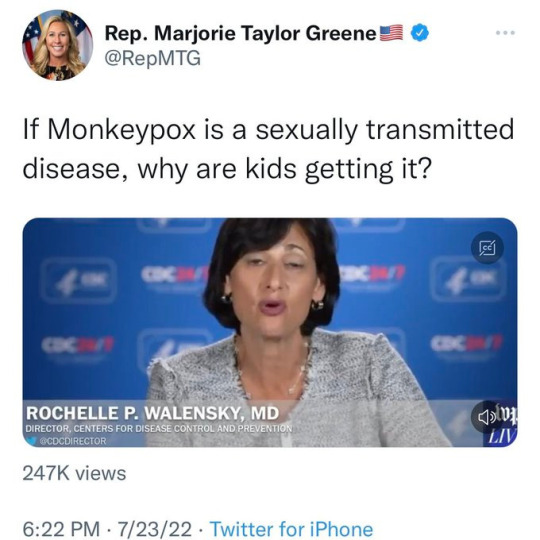
Here is probably the clearest example of violent homophobia, in the legislature even, implicitly linking gay and bi men -- as they have been reported as the primary cases of monkey pox -- to pedophilia under the guise of "just asking questions."
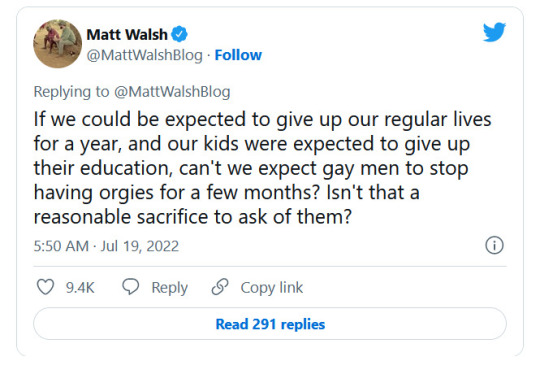
Matt Walsh, noted self proclaimed fascist and transmisogynist linking gay and bi men to promiscuity and almost hyper sexuality, while also implying that gay and bi men have some form of "special privileges" in that you can't question their behavior. Also notice the mention of kids and education in this tweet.
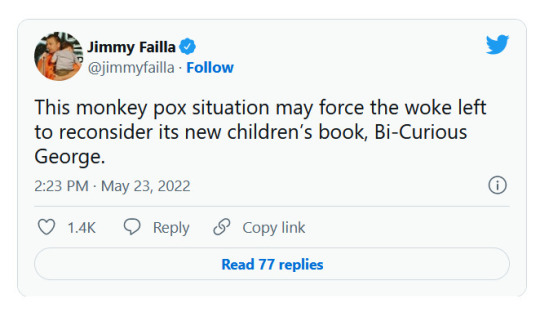
Fox News radio contributor Jimmy Failla linking a spate of current homophobic attacks together, monkey pox, LGBT children's books, and "wokeness."
Here is the article the last two tweets were taken from which also includes an overview of the situation and reaction from conservative media. Again and again we see LGBT people and especially gay and bi men used as scapegoats and their suffering the targets of mockery and slander as a way to ignore the real danger a monkey pox outbreak presents. In the conservative and reactionary mindset, gay and bi men are already linked with disease, extreme promiscuity, and pedophilia and it has been that way since the 50s and again in the 80s and the early 00s, any time LGBT people and issues hit the mainstream media and become extremely visible homophobia and transphobia increases incredibly, which we see happening again now in multiple ways.
Especially now we see the presentation of LGBT people as a danger to children. This is only the beginning, as people have pointed out this rhetoric is likely to get worse as more children get infected with monkey pox once school resumes. Here we see how the deliberate ignorance of framing monkey pox as an exclusively gay STI is here to link one imagined sex crime panic to another. I am, of course, talking about the "groomer" rhetoric spread in large part by the account LibsofTikTok.
Some quick background information for those who haven't been following this specific thread of hate. While the homophobia and transphobia LibsofTikTok (I will use LTT for short) peddles is as old as dirt, this is an account that has inspired a particularly large backlash against the LGBT community in large part due to it's connection with Fox News and conservative politicians. LTT has been operating since the creator, Chaya Raichik, made the account in November of 2020. However, the account reached a peak in April of 2022 when an article by Taylor Lorenz was posted uncovering the creator and Raichik used the article as an excuse to cry doxxing despite her information being easily accessible enough and her notoriety warranting the article. At this point Raichik buddied up to Tucker Carlson so they could both decry the "violence" of the left while LTT was posting homophobic and transphobic violence every day under the guise of "just reposting TikToks of 'libs' owning themselves."
At the same time LTT has a habit of calling any LGBT person a "groomer." Specifically here I want to bring up LTT's pattern of posting videos and tweets of LGBT teachers and trying to get their followers to get them fired. These teachers have not done anything wrong, except in the eyes of conservatives where simply being out as gay or trans is a way of sexually "grooming" kids by exposing them to the concepts of...being gay and trans. LGBT people are presented as a danger simply for existing in proximity to children, and even more dangerous if they try and affirm LGBT children. Should monkey pox spread in schools due to the lack of urgency on the part of the Biden administration, LGBT teachers are going to be at even more risk for unlawful firing and hate crimes than they already are.
I mention hate crimes because LTT and other conservative media have not been shy towards spurring them on. Recently, there's been multiple instances of gay bars, drag shows (and especially Drag Queen storytime events), and libraries getting swarmed by angry parents, Proud Boys, and neo-nazis, often armed. They've been informed of these events by accounts like LTT posting about them and sensationalizing them with Raichik's groomer rhetoric. You may remember a picture spread on Twitter of children at a drag show at a nightclub in Texas, where people expressed horror at a sign that said "it's not gonna lick itself" in the background as a sign of deviant grooming and pedophilia. I don't want to undercut how serious the rhetoric around this event was, but as someone who just watched all of the Shrek movies recently... kids have heard worse. The real issue these people have is with children being exposed to drag and different ideas of gender, which they view as inherently sexual. Although there were some useful idiots who furthered transphobia with their mostly genuine hand wringing about an easily explained away innuendo, unwilling to see their part in spreading the trans panic further.
A quick note on all of these protests, although they're really violent intimidation against the LGBT community, is that the police have deliberately failed to step in in all of them and instead allowed these attacks to happen freely. The police have never and will never be on the side of the LGBT community as they are a tool of state repression and always have been. While Lawrence v. Texas is still the law of the land and sodomy is legal and gay bars are free to operate and book all the drag performers they, the police have no legal way to harass the LGBT community. Until laws legalizing sodomy were passed it was legal to entrap gay men by flirting with them until there was enough evidence there was conspiracy to commit sodomy and prosecute them. Some police departments even had whole squads dedicated to this "moral cleanup." And there is history of gender nonconforming and transgender people being hit especially hard by police raids on gay bars. With the police no longer able to intimidate the community under homophobic and transphobic laws, it's fallen on their comrades in the Proud Boys and other fascist groups to do it for them under the guise of reasonable concerns.
Because what it all comes down to is that "think of the children" has always been an excuse not to actually advocate for the welfare of children in any way from education to healthcare, but as a cheap way to start a moral panic on demand. Please, as much as you can, be aware of the climate LGBT people and especially gay/bi men and trans people are facing. These attacks have been very dark signs to me, and they should be for everyone, and they've been happening for a long, long time.
2 notes
·
View notes
Text
As of the early hours of May 16, the Netherlands has been under a far-right coalition government led by the fascist Party for Freedom (PVV), already the largest party in the House of Representatives. The coalition includes the conservative People’s Party for Freedom and Democracy (VVD), the Christian-Democratic New Social Contract, and the right-populist Farmer-Citizen Movement.
...
The coalition agreement has 26 pages. The document is not very specific on many points, and after almost six months of negotiations one might ask what they have actually been talking about during this long period. However, when it comes to topics such as migration and refugees, the fascist and xenophobic character of this government becomes very clear.
...
These paragraphs deal with the possibility of placing the field of immigration law under a state of emergency, governed without parliament. They also open up the possibility of ignoring international treaties on immigration and asylum policies.
...
Importantly, with its planned migration crisis law, the government wants to put all asylum procedures on hold for at least two years.
...
Moreover, the coalition agreement states that the government wants to “adjust” EU treaties and regulations on migration and advocates “a modernisation of the UN Refugee Convention” of 1951 “and will seek cooperation with like-minded member states at the United Nations” to achieve this. Many may laugh at the fact that a small country like the Netherlands wants to launch this initiative against the UN, but what if the far-right wins the upcoming EU elections? What if Trump wins the US elections? Leaders like Meloni and Sunak would also probably support it.
...
As could be expected from a far-right government, the document also announces “a visible presence and more police and police stations in the districts, in the neighbourhoods, in the regions; the criminal investigation department will be strengthened”, and there will be harsher penalties for “deviant behaviour” – a term not described in detail. There is to be a clear distinction between peaceful demonstrators and people who jeopardise “public order”, with significantly harsher penalties. The definition of what a terrorist organisation is also to be expanded – again the document does not say exactly how.
...
The coalition agreement also states that public broadcasting in the Netherlands needs to be reformed, with a cut of 100 million Euros. Decision-making processes are to be streamlined. What this sentence exactly means is not described. And of course, climate denier Wilders is also taking aim at several carbon-cutting measures, with the promise to raise the daytime motorway speed limit back to 130 km/h and renewing the subsidy on “red diesel” for farmers.


just copying the header image here bc it's so cool :)
the main question today is
but what if the far-right wins the upcoming EU elections?
fortunately there are several people's initiatives you can join to help the work against this possibility
from Avaaz
from WeMove Europe
as some examples
check out the campaigns, find your tribe, find the way you want to be part of the action
0 notes
Text
Fulfillment Security: Protecting Your Inventory from Loss or Damage with Texas Logistics Service
At Texas Logistics Service, we understand protecting your inventory against possibilities of losses and damages is very important for your business. Smart supply chain fulfillment security is not just a safety measure you set aside in case of unexpected circumstances. Rather, it is a significant aspect of your supply chain functioning that determines your profits in many ways. This post explores fulfillment security and the fact that its solution is guaranteed by Texas Logistics Service, for your peace of mind.
The Importance and Impact of a Fulfillment Security
Your inventory as the main nerve of your company, its safekeeping and validity are critical because it is closely connected to your clients, sales, and image. A secure fulfillment procedure shields your products from loss, theft, damage, and various dangers that should not be permitted to impede organizational operations. Here's why fulfillment security matters:
Cost Savings: Preventing loss or damage reduces costs associated with replacing inventory or compensating customers for missing or damaged items.
Customer Trust: Product delivery in a safe manner and with timely shipping increases customer confidence and bridges the gap of getting customers again and again and positive feedback through word-of-mouth.
Business Continuity: Impeccable fulfillment system secures the fee operations and even during unexpected deviations allows the business to keep functioning at its best.
Compliance: The correct security precautions will provide you with the opportunity to follow industry regulations and standards, which will lower the chances of committing mistakes that in the long run can translate into fines and lawsuits.
“Texas Logistics Service is dedicated to fulfillment security as a basic principle of our logistics.”
Here's how we protect your inventory and give you peace of mind:
Advanced Security Systems: Our up-to-date premises are furnished with modern safekeeping methods, such as surveillance cameras, access control and alarms, that way no thievery or equipment damage happen and inventory is always intact.
Climate-Controlled Storage: To preserve your products against the natural elements, our climate-controlled storage areas are utilized to keep the proper temperatures and air humidity for the stocks of different types.
Secure Packaging and Handling: We are using pack materials and handling tricks of artistry proper for the industry to avoid the products from being blown away while in transport and storage, making their risk of damage reduced.
Inventory Tracking: Our inventory management systems utilizing cutting edge technology screens your products in real time making them visible. Thereby, preventing their misplacement or loss.
Disaster Preparedness: Regarding crisis management, we are well-prepared for any type of disasters that might come up, including fires or natural disasters. This ensures that your inventory remains protected and recoverable.
Staff Training: It is a matter of pride for us to state that our team of professionals that has been regularly trained on particular security protocol, the best practices, and safety measures will be extremely secured during the fulfillment process.
Joining Texas Logistics Services will let you relieve your worries about your business since our major concern is how your outcomes can be positive. We ensure that the fulfillment safety of your products is not a headache but on the contrary, a solution. So you can focus fully on growing your business with us without being worried about your products safety. Let us facilitate the process of organizing the logistics in such an ideal way to ensure both peace of mind and perfect execution with our number one logistics services.
Are you ready to exploit the advantages of Rock solid Fulfillment Services from Texas? Today is the day to consult us in order to learn more details about the personalized solutions offered to cover your inventory and carry on with your business development.
1 note
·
View note
Text
All We Can Save - review by Luiza Whately
Provide an overview of the anthology and describe the most resonant aspects of the book. (2-3 paragraphs)
The book edited by Ayana Elizabeth Johnson is an interesting and different reading experience. This book addresses the most important crisis we have in the world right now, climate change, but in a very uncommon way, not bringing only facts about natural tragedies and scientific data, but also bringing personal stories and experiences, through the lenses of empowering and inspiring women who decided to take action regarding the topic, or reflect on ways that it might affect communities in our society. This book does not only address the Climate Change topic but also the feminine power to make a change and the importance of having more female figures in leadership positions to achieve change.
It is amazing how the editor combined such different backgrounds, from indigenous women to mothers, lawyers, mayors, educators, and journalists… ensuring that different information would be covered for the reader. But still making the topic relational to the readers.
Climate change is affecting our lives in ways we can never measure. Other crises are related to Climate Change crisis and many people don’t realise their relationship. Or if they are aware many, (being a big part of them) corporative leaders choose not to care, as the effects of their acts would only be visible at a further time in history. However, as Sherri Mitchel, one of the writers mentions “ We must recognize that Climate Chnage is only one symptom of a larger problem. Human beings have fallen out of alignment with life. Their beliefs and ways of being have shifted dramatically from those of their ancestors, taking them further and further away from the sources of their survival.”
Why do you think the editors chose to include so many voices using different formats of self-expression? (2-3 paragraphs)
By providing us with the reader’s different perspectives on the topic, it was possible to analyze the problem from lenses that I would never before imagine, such as the lens of a woman who lived in Hawai and experienced the population worries about the floats and the next years of their island. Or the point of view of a very religious woman who explains and connects climate change to her religious mission in this life.
More personally, I think that seeing all of these different forms of self-expression coming from women, just made me feel empowered as a woman to don’t wait for a command, or join an initiative that has already been started, but to take action on my own. There are so many ways of doing that, and this book is proof of that.
Does this book provide concrete solutions? Does it inspire hopefulness in you as a reader? Why are hope and solutions important in these times? Provide six specific quotes and examples from the book.
This book doesn’t have a concrete solution, instead, it has a call to action and an infinite reflection on the topic. Each writer has their own story, but all of them advocated for love, compassion, strength, and prosperity for a better world, and ways that we can all work together to fight climate change and other crises related to it. On the last page of the book, Ayana E johnson and Katharine K Wilknson say that they hope that this book embroidered a kindred circle and that it awakens in each reader a ferocious love for Mother Earth, and each other.
I think that was a great way of summarizing the book and I hope that others were able to finish this book just as passionate about each of these stories as I did.
It is too easy to be sad about the fact that the world might end. It is too easy to be conformed, not caring about the next generations, and not believing that Global Warming is true. It takes passion, courage, determination, and hope to make a change, and that is why I believe that this book is such an important reading for young design thinkers and students. Here are some quotes ( there are so many others) that will stay with me:
“We know we don’t have time to sit around and wait for someone else to make decisions. Instead, we are simply finding ways in our communities to effect change.”
“Communities, our mothers, and our daughters are depending on us, and because our ancestors are watching. We shall make them all proud.”
“I was born during a phenomenal burst of consciousness and lawmaking, and I come to cherish our bedrock environmental laws as a birthright.”
“Our sense of responsibility for the coming generations is reflected in this awareness.”
“This project is an example of the opportunity that adaptation investments present. It will transform the waterfront of the Lower East Side with a park that will serve the community while also protecting it.”
“Across the country and the world, community by community, people are building microcosmos of the systems and societies we need to reverse the tide of catastrophic climate change and become a world that respects all rights for all people, in harmony with Mother Earth.”
“We must make fundamental shifts: from a society that drills and burns to power our communities to one that harnesses the sun and the wind; from a society that buries or burns our waste to one that recovers, reuses, and recycles, from a society that genetically modifies, trucks and ships food to one that advances local productions of food that is nutritious and accessible for all.”
“We are never far from the answer to the problem we have created- it is within each of us.”
A. Many of the contributors to All We Can Save have had long, varied trajectories to and in climate work. Choose a contributor from the book who you identify with. Research their story and learn about their climate awakening. What galvanized them to take action? How did they develop their expertise? How did they locate community support, and what groups have they helped to form or elevate? Why does this person's story inspire you? Give concrete examples. (4-6 paragraphs)
Sherri L. Mitchell -
Weh'na Ha'mu Kwasset is a Native American lawyer, author, teacher and activist from Maine.
Sherri has a deep connection to Mother Earth, coming from a Native American background she shares her culture, traditions, and perspectives with people who don’t have the same connections with grounding as she does. And that is why I love her writing. I grew up in São Paulo, the biggest city in South America, however, during my whole life I had the privilege to be connected to nature at the farm. My family is from the countryside, and the farm became a space of deep connection to nature, myself, and my loved ones. During the pandemic I moved to the farm and for 5 months I lived an alternative realizing that in my mind was never before possible. No internet, (wifi in some spots) animals everywhere, people with different backgrounds than mine, different values, different perspectives of life, calmer, more attention, people that had a deeper connection to nature and with their surroundings.
When I read Michell’s text and her reflection about the connections of the trees, and the way that nature works together to survive and thrive, I minimally understand what she is saying, I emphatize, I connected and I agree a million percent.
Nature has been in our planet for much longer than we did, they are the best professors we could possible have. And indigenous people know that, they value that connection, which very few of us do.
Michelle knew that, and knew the importance of sharing indigenous beliefs and ways of living as one way to provoke change. Do to that, she started her career as a lawyer, teacher and activist. Her goal was to keep her mothers and acestrals beliefs and practices alive for a more united, conscious way of living. With that in mind, some of her actions were, to write a book, participate in several podcasts, get involved with initiatives from different parts of the world that would help native people, natura and practices to try slowing down Global Warming.
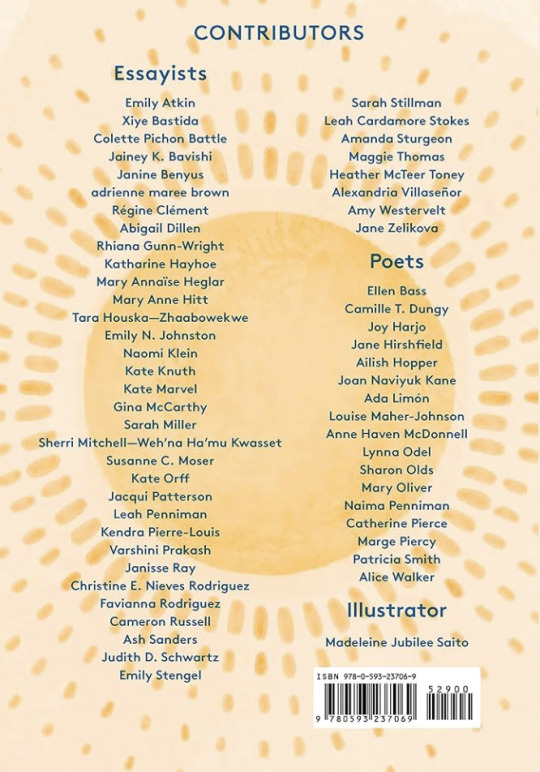
0 notes
Text
‘Conversation Pieces’ @ Supergau
This article was first published in the online SuperMag - magazine from the Supergau Festival.
The chance to publish a report in the Supergau Magazine is a nice opportunity to invite you to get involved in the upcoming Supergau Festival. I am a Dutch artist living near Rotterdam. The beauty of art is that it has many forms and possibilities. I am especially interested in the social insights that art can offer when we work together. In order to create meaning, I try to get to know the Lungau region and the people who live there.
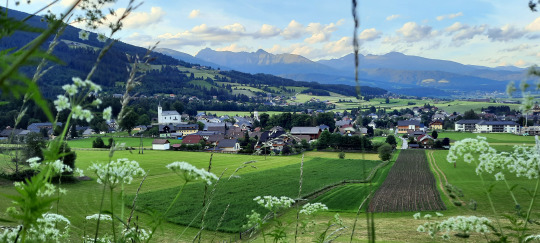
Therefore I felt excited that I was invited in June by Tina Heine from Supergau to come to this beautiful environment. We stayed at Hotel Post with a large group of artists. After a two-day car trip with my wife Hristina we were welcomed by the Mayr family in Mauterndorf.
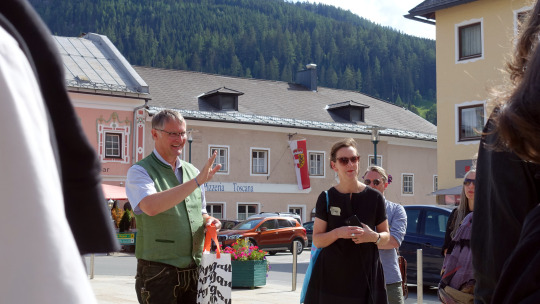
It was an impressive weekend with many special encounters and conversations. We were warmly welcomed by Tina Heine and Matthias Ais & Martina Berger Klingler from Salzburger Land. Afterwards we were shown around by Mayor Georg Gappmayer of Tamsweg and enjoyed a wonderful diner in the Kuenburg Castle. It promised to be an inspiring weekend.


During my first online research I had read about 'Landflucht'. That's what it's called when young people exchange the countryside for the big city. This theme intrigues me because it says something about the preferences we have. Where do we want to live and under what circumstances? During my stay in the area I spoke about this theme with a variety of people.
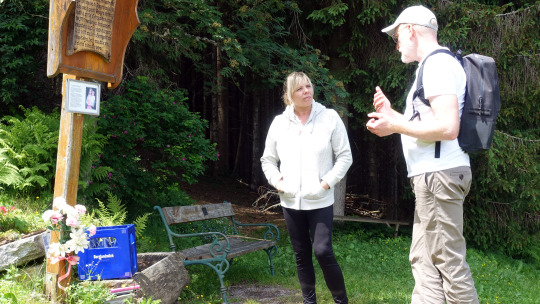
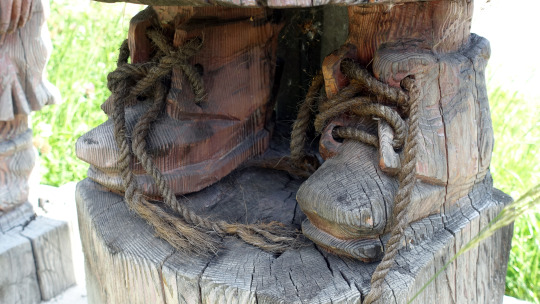
I saw that local traditions and rituals have an important place in daily life. At the same time, I noticed that these old traditions are announced today as events in the tourist agenda. It got me thinking. In the Netherlands there is little left of the old traditions outside the famous touristic sites and villages.
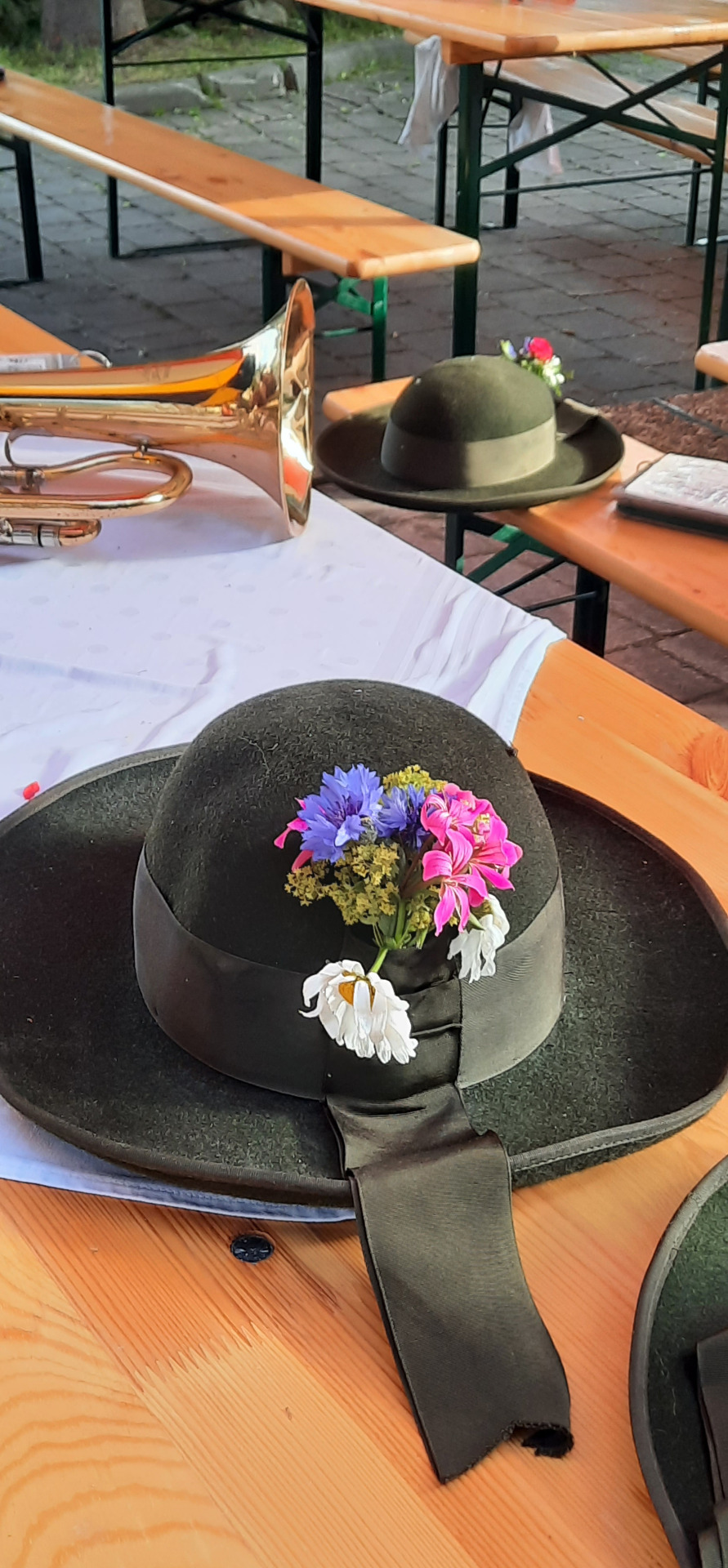
It strikes me that 'Landflucht' is often seen as something negative. Empty shops can be witnessed here and there. Due to globalization there is a worldwide tendency in which people, knowledge and resources are mainly concentrated in and around the large cities. But new technologies offer also the opportunity to attract people from abroad and to revitalize shrinking communities.
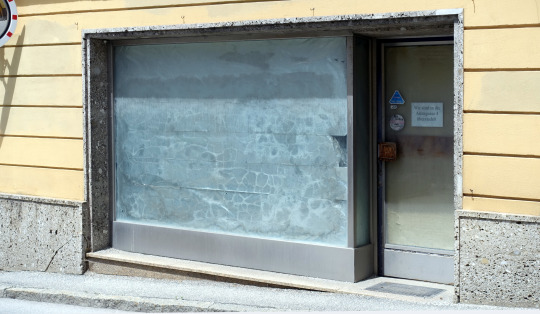
The youngsters I speak to or read about go to study in Saltzburg, Graz, Wien or Linz, for example. One of them pointed out the long traveling time from Vienna to get back 'home'. The qualities of the countryside are slowly fading into the background it seems. I wonder whether climate change and the corona crisis might shed a different light on this?

Among the people I spoke to were also youngsters who came to this region to work from outside Austria. The question that arises from these conversations is how accessible the local community is to newcomers? I read on the internet that you can even feel an outsider if your parents come from Graz. So how do you maintain the rich local traditions when your own population is shrinking?

We attended a presentation from Georg Macheiner about Lungau as the largest biosphere park in Austria. On the website of this model region for sustainable development, I see the future vision presented of a boy and a girl on an alpine meadow, dressed in traditional clothing. Heike Posch of the Supergau organization explained to me that this clothing is passed on from generation to generation and is therefore very sustainable. I wonder how do I relate to this image if I would like to come and live in the Lungau region?
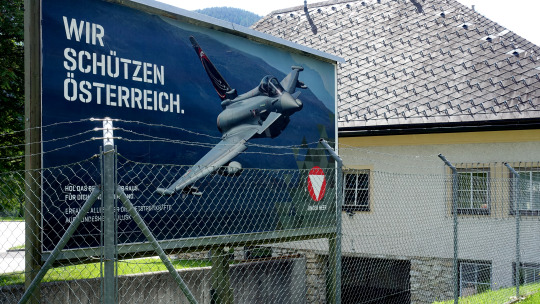
The Lungau region has a rich cultural past and that past is visible wherever you look, but what about the picture of the future? This billboard near Tamsweg with 'We protect Austria' makes clear that the future must be above all a safe future. But how do you bind young people to this region and invite them from abroad to contribute and built a future in Lungau?

In the line of this question I am collecting ideas for the development of this area. I'm curious what do you think? For example, someone told me, “why don't we create flexible workspaces in the empty shops of Mauterndorf?” By placing construction boards at various locations during the festival in 2023, I want to expose these ideas in their environment and offer 'windows of opportunity'. What possible developments in your town or village make the Lungau region attractive for youngsters?
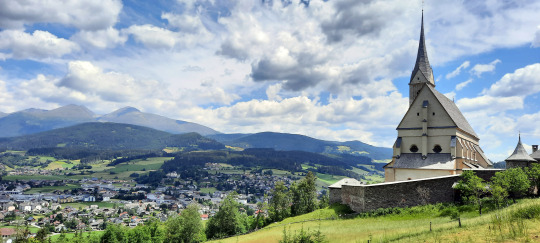
Let me know if you want to contribute with your ideas to ‘Conversation pieces’ or if you want to help realizing this art project: info[at]edwinstolk.nl I will return to Lungau in September and would love to meet with you in person. The beautiful photographs in this article were made by my wife Hristina Tasheva.
All the best,
Edwin Stolk
0 notes
Text
15 Up-and-coming Trends About Eddie Rockets
We're right here to offer food businesses with the most updated information concerning COVID-19. We've put together every one of our expertise from the best readily available sources and have included suggestions on points like what to do in the event of a COVID-19 break out in your location.
A pandemic situation is not something that is going to occur simultaneously or over night. With each passing day we are seeing new challenges arise that could potentially be more significant than the last. This is especially real with the Coronavirus. This short article is contacted give suggestions as well as pointers for those in the eliminate food service about exactly how to maintain consumers safe as well as secure during this pandemic situation. It's important to do every little thing feasible to ensure the consumer's security is constantly a priority.
The coronavirus pandemic has impacted the globe's economy. As well as with dining establishments facing a significant difficulty in keeping their company, it's an excellent time to consider just how to maintain consumers risk-free and also protected.
Our advice blog covers topics like ideas and also methods for remove food businesses during the coronavirus dilemma, how to make it simpler for clients to pay by card, how to obtain customers to stay at home, as well as much more.
This blog site includes suggestions on maintaining take-away food services risk-free throughout the Covid-19 break out, plus pointers for ensuring your customers fit and enjoying their meals.
We have actually additionally included guidance on just how to preserve your on-line visibility, whether that suggests continuing to accept on the internet orders or not. This overview is designed to supply advice for take-away food companies about just how to maintain customers risk-free as well as secure during the Coronavirus pandemic. The coronavirus crisis has actually been a large obstacle for take-away food services, and with every passing day there are new challenges that arise. This overview will certainly provide you the details you require to make sure your organization can survive via this difficult time. COVID-19 Update: We have upgraded this write-up to consist of several of the most recent info concerning the coronavirus and exactly how it may impact take-away food services. You can find out even more here: https://www.takeawayfoodbusiness.com/covid-19-update/ We've assembled all of our understanding from the best available sources and also have consisted of advice on points like what to do in the event of a COVID-19 episode in your area. A pandemic dilemma is not something that is mosting likely to occur all at once or over night. With each passing day we are seeing new obstacles arise that might potentially be much more major than the last. This is specifically true with the Coronavirus. This short article is written to offer suggestions and also pointers for those in the eliminate food organization about just how to maintain consumers secure as well as secure during this pandemic situation. It is very important to do everything possible to see to it the consumer's safety is constantly a concern. The coronavirus pandemic has actually affected the world's economic climate. And with restaurants encountering a significant difficulty in maintaining their company, it's an excellent time to check out exactly how to keep customers risk-free as well as safe. Our advice blog covers subjects like suggestions and also tricks for remove food services during the coronavirus dilemma, exactly how to make it simpler for customers to pay by card, exactly how to obtain consumers to stay home, and also much more. This blog has guidance on keeping take-away food companies risk-free throughout the Covid-19 break out, plus tips for making sure your customers are comfortable and appreciating their meals. We have actually additionally included advice on how to maintain your on the internet existence, whether that implies continuing to approve on-line orders or not. This guide is designed to supply support for take-away food companies regarding how to maintain consumers risk-free and safe and secure throughout the Coronavirus pandemic. The coronavirus situation has been a huge challenge for take-away food companies, and with every passing day there are brand-new obstacles that arise. This overview will certainly provide you the info you require to ensure your company can survive via this challenging time. We have actually assembled all of our knowledge from the very best offered sources and also have included suggestions on points like what to do in the event of a COVID-19 outbreak in your location. A pandemic dilemma is not something that is going to take place all at once or over evening. With each passing day we are seeing brand-new challenges emerge that might potentially be more serious than the last. This is specifically true with the Coronavirus. This write-up is written to provide guidance and also tips for those in the eliminate food service regarding how to maintain clients risk-free as well as protected during this pandemic situation. It is very important to do whatever feasible to make certain the customer's security is constantly a priority. The coronavirus pandemic has actually influenced the globe's economic situation. As well as with restaurants facing a major difficulty in maintaining their organization, it's a best time to look at how to maintain consumers secure and also safe.
Now that we've reached completion of this video clip, I wish to provide you some certain ideas for taking care of take-away organizations throughout these hard times.
Firstly, let me tell you something. It's going to get better. I'm unsure when, but it is going to get far better. I really feel actually poor for all the small company owners who are having to make life or death choices. And if you're having a hard time, I hope this checklist assists you.
You have to be open. I believe that's been one of the most apparent and difficult thing to adapt to in regards to service. But you should be open for individuals to come by as well as utilize your services. You can't require consumers to utilize your distribution solution. That is one of the most selfish thing you could perhaps do. Individuals need to use their very own services. If you can provide a choice, you must.
Have a clear messaging on the display. Tell individuals what is risk-free. Tell people what is not secure. Tell them that it is okay to be fearful. Tell them that you're taking steps. Tell them that the federal government is doing whatever in its power. Tell them that you are whatsfordinner.ie taking action which you are attempting to make a difference. Tell them that you care.
Have clear directions. Do not make your consumers head out the back door. See to it your customers are
N
A
P
1 note
·
View note
Text
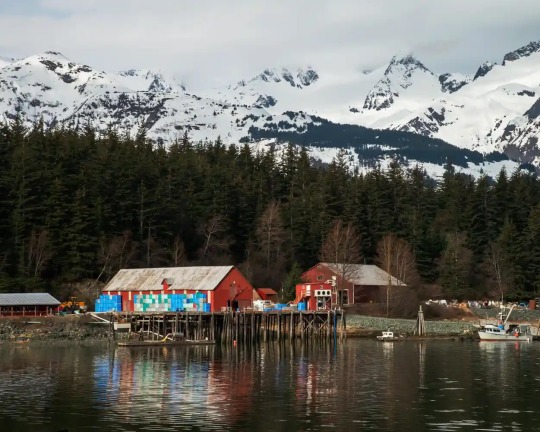
The Upper Chilkat Valley, looking north, with the proposed Palmer site out of view to the left. Photograph: Ben Huff/The Guardian
A Tiny Alaska Town Is Split Over A Goldmine. At Stake Is A Way Of Life
In Haines, where the Salmon once leaped under Snow-Capped Mountains, a massive mining project promises Well-Paid Jobs – and Threatens a Fragile Ecosystem
— By Dominic Rushe in Haines, Alaska | Tuesday June 22, 2021 | Guardian USA
For 2,000 years, Jones Hotch’s ancestors have fished Alaska’s Chilkat River for the five species of salmon that spawn in its cold, clean waters. They have gathered berries, hunted moose and raised their families, sheltered from the extremes of winter by the black, saw-toothed peaks of the Iron Mountain.
Now Hotch fears a proposed mining project could end that way of life.
Hotch has an infectious, boyish laugh – but there is no mistaking how worried he is about plans to build a mine where millions of pounds of zinc, copper, lead, silver and gold are buried, beneath the valleys’ mountains. We arejust miles from the headwaters of the Chilkat, the glacial river that serves as the main food source of the Tlingit, the region’s Indigenous people, as well as the inhabitants of Haines, the nearest port town.

“You guys might have your Safeway,” he says, waving his arm across the valley. “There’s ours all around here.”
Hotch, a tribal leader, lives in Klukwan, a village that takes its name from the Tlingit phrase “Tlakw Aan” – “the village that has always been”. It is the hub of an ancient trading route – later known as the Dalton Trail – that runs from Haines to Fort Selkirk in Canada.
Here in south-east Alaska, the consequences of the climate crisis are already visible. “Our mountains used to be snow-capped all year round,” Hotch said. “Two summers ago, our mountains were almost totally bare.” In Haines, hardware stores sold out of box fans because it was so hot.
King salmon – also known as Chinook – are in particular trouble. Haines’s popular annual fishing derby for largest species of Pacific salmon has been canceled, and now if anyone catches one, it must be released, in the hopes of encouraging their numbers.
“We need the snow to keep water cold for the salmon, for the summer blueberries,” says Hotch. Last year he saw fewer bumblebees, essential for pollination, and the blueberry crop was very disappointing. “I saw a bumblebee last week and I got real happy,” he laughs.
The mine, known as the Palmer Project, is still in the exploratory stage but financial control of the project was taken over by Dowa – a metals manufacturer and one of Japan’s largest companies – in a move that is seen as giving fresh impetus to the project.
If it gets approved, Hotch worries that contamination from the mine, located under the Saksaia glacier, could destroy the salmon runs they rely on. Even the exploration now under way could irreparably damage the fragile ecosystem, he believes, adding that the town would suffer too. Haines is heavily reliant on commercial salmon fishing, as well as tourism – each November, visitors flock to town to watch the largest convocation of bald eagles on the planet gorge on salmon.
“This project is a serious, significant threat facing our people,” says Hotch. “Some of the younger generation here now, they could say, ‘We were the last ones that were able to smoke fish, jar fish, pick blueberries,’” says Hotch. “We are working very hard to make sure no generation will have to say that.”

Jones Hotch, Klukwon elder on the banks of the Chilkat River with the village of Klukwon in the distance Photograph: Ben Huff/The Guardian
Mining has a long and storied history in the Chilkat Valley, stretching back all the way to the 1890s Klondike gold rush. Hopeful prospectors have been trying to strike it rich ever since Haines local Merrill Palmer – hence the name of the mine project – first laid claim to the site in 1969.
This year, plans to open operations finally took a significant step forward when Dowa took over the majority interest in the project from its Canadian partner, the exploration company Constantine.
“It is a decision by an investor, already highly invested, to put in additional money to further develop it and take control of the project,” Jim Kuipers, a Montana-based consultant, told the Chilkat Valley News. “Every year the project continues to get financed and ownership gets more consolidated it does become more likely to happen.”
Along the banks of the Chilkat, there are already signs of increased activity. The Haines highway is being extended to carry heavy trucks at higher speeds, and the state-run Alaska Industrial Development and Export Authority (Aidea) is proposing financing reconstruction of the town’s deepwater dock to include an ore dock that would make it easier to transport the bounty that the Constantine corporation believes the mine contains.
The economic turmoil triggered by the coronavirus has added impetus to the plans. The unemployment rate in Haines was over 14% in January. Meanwhile, copper prices have soared to record levels as large parts of the global economy emerge from pandemic lockdowns. The Palmer project would support 220 full-time jobs and 40 contractors, a significant boost to a town with a population of 1,863.
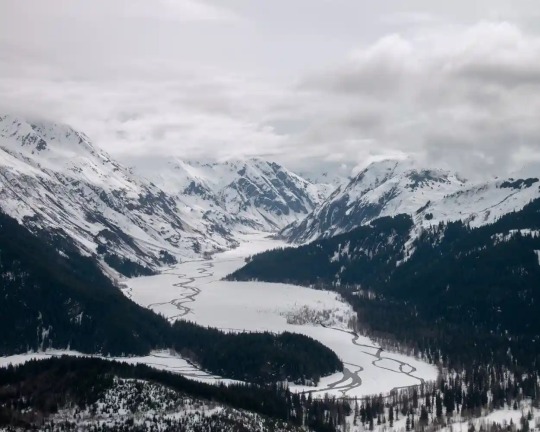
The Upper Chilkat Valley, looking north, with the proposed Palmer site out of view to the left. Photograph: Ben Huff/The Guardian
‘What we have here is special, not just for us but for the world’
For Gershon Cohen, a long-time Haines resident and project director of Alaska Clean Water Advocacy, rumblings that the mine may finally become a reality are “a nightmare”.
Cohen moved to Haines in 1984 and lives surrounded by trees in a beautiful wooden house he built himself – nothing out of the ordinary for Haines’s hardy, self-sufficient residents. On a walk to the shed he uses as his outside office, his wife suggests he gives me the “moose and the bear” talk. I joke I am a little old for that, but the dangers of the area’s two largest mammals are very real. Bears are likely to sniff you coming from a mile off and leave before you ever see them, but moose are easier to surprise and likely to trample you if spooked.
This is still a wild place. A record 40 grizzlies were killed in Haines last year, perhaps because poor fish runs and a bad berry season drove them into town looking for food (they have also been kept out of the local dump by an electric fence.) Bears, however, are smart – they have learned to open car doors to look for food and are not averse to breaking and entering houses.

Shannon Donahue: ‘Part of what makes this place so full of life is the robust salmon runs.’ Photograph: Ben Huff/The Guardian
“What we have here is very special, not just for us but for America and the world,” said Cohen. “There is a very real possibility that this mine will destroy the fisheries here. With the fish gone, there will be no eagles, no bears, no tourists. If this mine gets started it’ll be here for what? Ten years? What’s that against thousands of years of supporting this community?”
Haines and Klukwan are part of the Inside Passage, the longest and deepest fjord in North America and a place with a unique ecology. Cold, glacial freshwater meets the sea here, making it the perfect spawning ground for salmon and a critical corridor for bears, moose, lynx, coyote and snowshoe hares.
“Part of what makes this place so full of life is the robust salmon runs,” says Shannon Donahue, executive director of the Great Bear Foundation. The salmon transport nutrients from the ocean to the streams, they feed the bears and the eagles and their bodies feed the forest. But salmon are “pretty picky about their habitat,” she says.
Copper in particular can be catastrophic for them. Salmon can travel thousands of miles to return to the stream where they were born to die, using a smell memory bank to navigate one of the greatest migrations in the animal kingdom.
Metals leaked into streams can destroy the fish’s ability to find their way home, and“fugitive dust” shaken from trucks transporting extracted minerals can also contaminate the waterways, eventually building up to levels that can destroy the salmon’s unique homing abilities.
The mine’s supporters believe they can safely extract the Palmer Project’s riches. But even if they do, the mine’s “tailings” – the waste materials including millions of tonnes of contaminated water – will have to be managed forever.
For local opponents, one recent disaster comes to mind immediately. In 2014 the tailings at the Mount Polley goldmine in British Columbia failed, sending 24m cubic metres of mine waste into the local waterways.
The Palmer site sits on active earthquake faults and in an area prone to catastrophic landslides. Only last December, two people died and multiple houses were destroyed after record-breaking rainfall triggered a landslide in Haines, leaving a huge, brown scar on the hillside.
As he recounts the tragedy, Cohen shakes his head. “What could possibly go wrong?”

A seagull flies above hundreds of spawning chum salmon on a slough of the Chilkat River, just below the Tlingit village of Klukwan. Photograph: Peter Mather
‘It’s nerve-racking to even pick a side’
Alaska is heavily Republican and deeply pro-mining, but Haines is split on the project – and this includes the Native community, says local artist James Hart, a tribal council member of the Chilkoot Indian Association.
Hart is against the mine, but is wary of speaking out. “I am not a scientist, but I have seen what has happened in other places,” he says. “Worst-case scenario [is] it could potentially devastate and wipe out all of our salmon runs.”
Sharing that view in a small town where everyone knows everyone has consequences. “It’s nerve-racking to even pick a side or voice an opinion as a minority person,” he says. “The political climate in Haines makes it really hard.”
Hart’s mother has long been involved with tribal politics and and is another opponent of the mine. Recently people yelled at her in the street “just for having an opinion”, he says. “It’s not even an opportunity for having a dialogue, it’s just yelling because you have an opinion.” The incident made him more nervous for himself and his family.

James Hart, an artist and activist. Photograph: Ben Huff/The Guardian
Support for the project also runs deep. Jan Hill, Haines’s former mayor, is also Tlingit and a First Nations member of the Southern Tutchone. Her family has deep ties to the community and the project; Palmer was a friend of her parents.
“Mining is kind of in my blood,” she said. Her great grandparents came up to Alaska in 1898 from Washington state for the Gold Rush. “We have dealt with resource extraction in this community and it’s worked well for us. For the most part it is done responsibly and that’s what is important to all of us,” she said.
She points to Constantine hiring local people who can buy homes offering “good-paying summer jobs” for students and purchasing all the goods it can in Haines. And experts at Constantine offered help after the recent fatal landslide that would not have been available otherwise.“They stepped up immediately,” said Hill. “They are a part of our community.
“None of us want bad things to happen to our fish or any of the wildlife. We live a subsistence lifestyle here. We depend on our fish and moose, the bears and ducks – all the creatures that God gave us. We all have these concerns, but I believe Constantine is very responsible. They are very regulated, they are good stewards of the environment.”
Garfield MacVeigh, Constantine’s chief executive, says he listens closely to the community’s apprehension. “We hear and appreciate those concerns. All the work we are doing is to demonstrate that we won’t be a threat to the environment. If we can’t demonstrate that, you are not going to build the project,” he said.
He points to a similar-sized mine, Greens Creek silver mine near Juneau, about 80 miles as the eagle flies from Haines, which went into production in 1989 and has been operating for 32 years without any obvious impact on salmon.
Asked about Hotch’s concerns, he said: “I hear them, and as far as I am concerned they [the Tlingit] will be there for another 2,000 years, because we won’t take a risk that would result in any threat to the river environment.”
Many of the concerns about the impact of the mine were unscientific, he said, and comparisons to the Mount Polley catastrophe were “very misleading”.
“These days you are seeing virtually every project, anywhere, being contested. You have got the extreme group on one end contesting all of these things. They seem to become political rather than scientific. That’s their intent, to create noise around this and make it more and more political. The more extreme element doesn’t seem to be interested in the scientific data that may or may not justify the project,” he said.
Cohen dismissed MacVeigh’s comments, saying that there had been plenty of evidence, including from state reports , of high levels of pollution near Greens Creek.
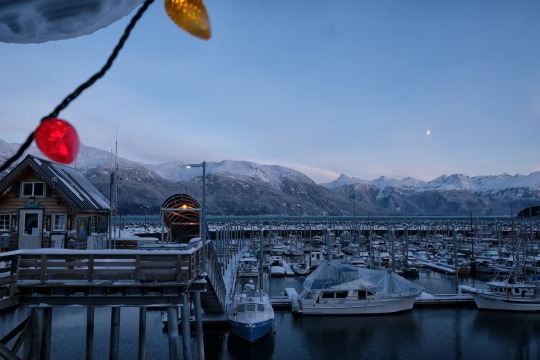
‘Haines is definitely a divisive little town. But what doesn’t get said is a lot of people are very engaged,’ said Kyle Clayton. Photograph: Peter Mather
Holding strong opinions can be hard in a small community. Other Haines residents were happy to talk as long as they were promised anonymity. One said it was particularly hard for the younger generation to speak out. The pandemic recession hit the town hard and, given its isolation, life was already too expensive for many here. “My friends are moving away,” he said. “I’m lucky – I’m working. But I can’t afford to piss anybody off. Older people have less to lose.”
He suggested I go and check out how much a gallon of milk cost in the local supermarket. A gallon of 2% milk was $6.89 in Haines, while the national average in April was $3.58. Nearby, the supermarket was selling organic cucumbers for $2.29 a piece, compared with $1.49 in a Whole Foods in Brooklyn.
It’s not just the mine that divides Haines. The town has a long reputation for sharp-elbowed politics and bitter generational infighting.
Few people know that better than Kyle Clayton, publisher of the Chilkat Valley News. Trying to objectively cover the Palmer project is a hard task. “I piss everybody off,” says Clayton. “I’ve been called a lackey for the mine.”
A handsome 36-year-old, Clayton has the worried look of a peacemaker. “It comes from all directions. The good thing is that in a small town, you can talk to people and reach some kind of understanding.”
He dislikes the black or white nature of the debate. “There’s a lot of unknowns. It’s still a long way off from being a project,” he says. He wants to see more information before deciding whether he should take a side.
On his paper-strewn stand-up desk is a list of 22 questions to be asked of interviewees to “complicate the narrative”, to “amplify contradictions and widen the lens”. In this hyper-partisan age, he is determined the paper will try its hardest to be fair to both sides.
People warned Clayton of Haines’s reputation before he moved from Petersburg, another small Alaskan town south of Juneau. These days, he thinks it’s not so different from much of America. When he speaks to people back home, they tell him people there are at each other over face masks and Covid vaccinations.
“Maybe we just did it first?” he says. “Haines is definitely a divisive little town. But what doesn’t get said is a lot of people are very engaged,” he says.
As plans for the Palmer Project pick up, the community and the wider world is likely to get even more engaged – and enraged. The Biden administration recently banned drilling for oil and gas in Alaska’s Arctic national wildlife refuge. Alaska’s Republican governor, Mike Dunleavy, called it an “assault on Alaska’s economy”.
But the opposition to the mine may not come entirely from the left. Last year Donald Trump Jr, the former president’s son and a keen hunter and fisherman, joined opposition to the controversial Pebble mine at the headwaters of salmon-rich Bristol Bay. That project is now in jeopardy.

An eagle takes flight from a perch along the Chilkat River, in the Chilkat Bald Eagle preserve, 10km downstream from the Tlingit village of Klukwan during the fall chum salmon run. Photograph: Peter Mather
Hotch said his community would be fighting hard to make sure Merrill Palmer’s gold stays underground. No short-term gain is worth the risk involved, he said.
“There might be money for five, 10, 15 years and then they will leave for the next spot, wherever that is. And we here will have to live with the consequences of what they did to our lands.”
More than anything, he wants the way of life that has supported his people for 2,000 years to be protected.
“I long for the day we can stop having to do this and look at ways that the salmon can have a friendlier way swimming up river. That’s how we can help them. That’s my goal after we finish this battle. They have been helping us for generations. It’s the absolute least we can do.”
#Alaska | USA 🇺🇸#Small | Tiny | Town#Split#Goldmine#Stake#Haines#Salmon 🍣#Snow-Capped Mountains 🏔️#Well-Paid Jobs#Fragile Ecosystem | Threatens
2 notes
·
View notes
Text
In Memoriam: On Metaphors of Spasoje Krunić
Exactly six years ago the Unfinished Serbia tour took place in Belgrade, where we have met prof. Spasoje Krunić, an architect, educator and fighter. He strongly believed that Architectuul has an important influence on the dissemination of architectural knowledge, therefore he was devoted to our stories, which he could follow regularly online. In his last post to Architectuul he shared his model of primary construction form for the village for refugees.
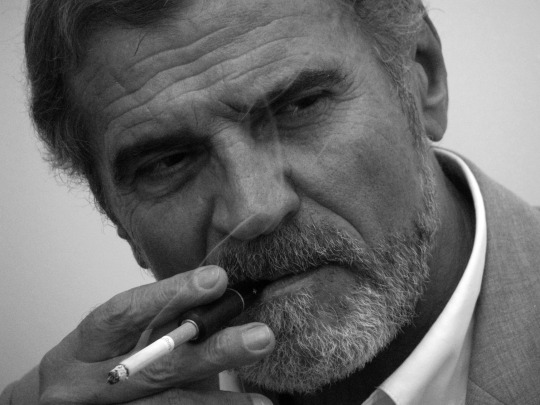
His lifetime determined a change of three different countries, born in the Kingdom of Yugoslavia, lived and worked in socialist Yugoslavia, and died in today’s Serbia. His work was influenced by the architecture of Louis Kahn, Frank Lloyd Wright, Le Corbusier and Jože Plečnik.
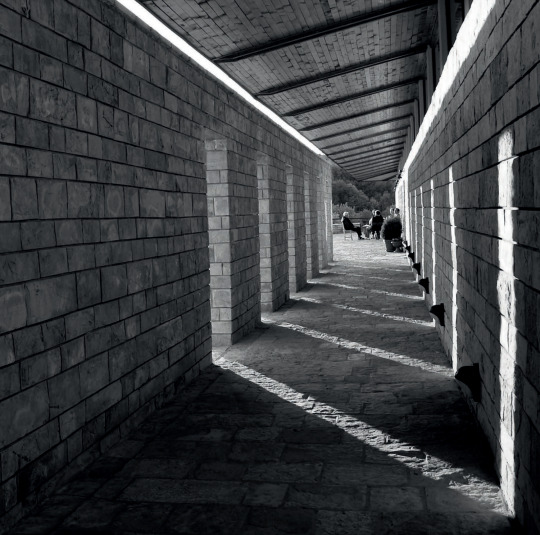
The play of the light and shadows in the Memorial Ravna Gora (1998).
***
Here I will not talk only about the creative work of the architect Spasoje Krunić. I am more inclined to talk about his courage and determination to persevere faced with pressures of the world we live in. His metaphors, both in architecture and in public life, increasingly assure me of this.
I do not intend to interpret his work and even less so his life, nor is my aim to address representation, which really says nothing about represented. My intention is to look at things and relationship between things in his life and work from the standpoint of objective phenomenology.
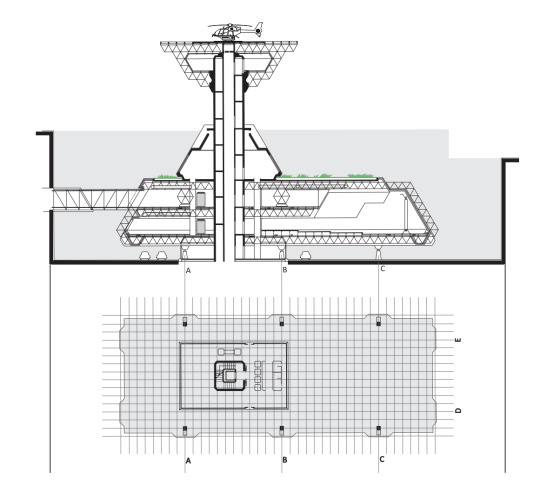
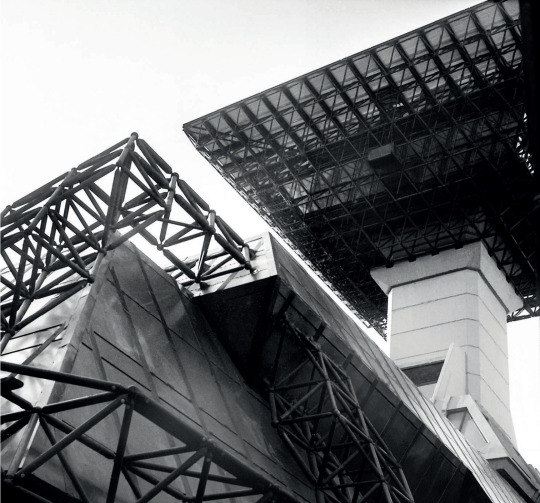
Police Command and Operation Centre in Belgrade (1979).
Of course, it is quite possible and I am certain that I know little about the personal history of Spasoje Krunić. But little that I know I learned from his metaphors – or rather creative allegories inspired and instigated by his strict adherence to the principles of modern architecture and the modernist movement, to the extent it was possible, given the reactionary and revisionist period in which he has been creating.

I will not talk about the childhood of Spasoje Krunić, not because I know practically nothing about it, but mostly because childhood is a hazy period that our minds know nothing about. For this reason, I will talk about his youth and adulthood. In fact, I intend to present and prove the hypothesis that Spasoje Krunić, in his life as well as his creation, he was in some kind of situation of his own, that he has been is true to the ideas of universality and singularity – he would call it communality. During his studies of architecture, he already manifested virtues to a high degree, which he lived by all his life. In this period, he advocated energetically that the academic community should gather and unite around progressive ideas that would lead up to the changes, which brought him into the very centre of social events at the university. Back then, he had an outstanding level of militant spirit thanks to which he tackled problems directly. His vigilance and attention paid to the milieu he lives and works in and to architecture above all, have stayed with him to the end of life.
I do not want to omit here, but on the contrary, I intend to point out in particular the relationship of Spasoje Krunić to his professors and seniors. Such an attitude indicates his spiritual health, which will follow him for the rest of his life despite the difficult times we live in. What he set up back then, and the way he did it, has been developing to the end of life.

Tašin-Bugarin House in Zrenjanin (1980).
Following his graduation, young Spasoje Krunić faced his first significant and major professional and creative challenges. On the one hand, he acquired extremely important experience, creating in situ in small communities in Serbia, strengthening his character and preparing himself for major masterly projects. In this period, he created beautiful metaphors, in my opinion, for the relationship towards climate and place, materials, structure and proportion, in works that are here to stay, such as: Gallery Jovan Popović in Opovo (1969-1970), The Cemetery of 6 000 people executed in 1941 in Kraljevo (1970-71), semi-detached house Tašin-Bugarin in Zrenjanin (1975-1980), which represents, in my opinion, the final phase of his youth. It is easy to notice that, at the very outset of his creative period, these metaphors were a homage of a good student to his teachers or, as he likes to call some of them, to the apostles of Serbian architecture – Bogdan Bogdanović (relationship to place and landscape), Nikola Dobrović (relationship to structure), Stanko Mandić (relationship to material) and Milan Zloković (relationship to proportion).
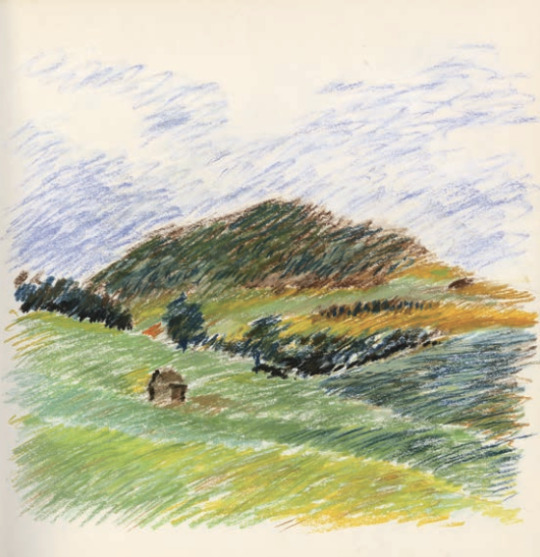
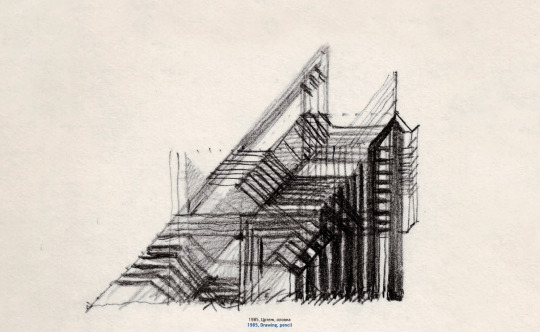
His dedication and commitment, and above all an extraordinary discipline in creation through all phases of appearance of the Being-here-in-the-World, as well as his exceptional perseverance in being present on the spot, it is all visible even today in the durability of the very logic of his work – from masterly and perfectly elaborated and implemented details to brilliant articulation of architectural shape, form and space. Thus, in the period of his youth, he created first things in art (experimenting with structure, proportion, form and place), in politics (experimenting with social engagement) and science (experimenting with construction, materials and urban planning). It was a remarkable and important preparation for a phase that I will refer to as his adulthood.

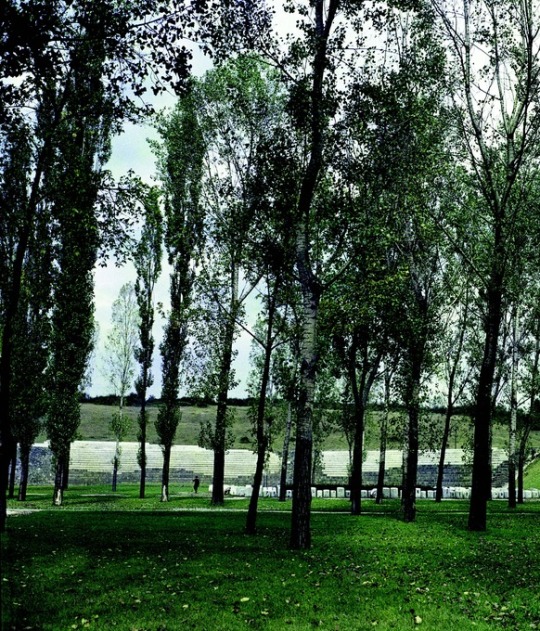
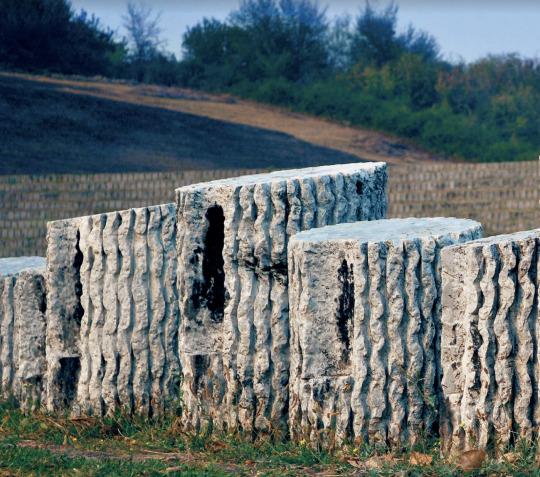
The Cemetery of 6 000 people executed in 1941 in Kraljevo (1971).
I will refer to the third phase in Spasoje Krunić’s life as adulthood rather than his maturity because he has shown and proven his maturity early on, during his studies of architecture, as well as later on, over and over again. In his adulthood, he has slowly but surely caught up with his teachers, becoming a teacher himself and a man of influence and respect. He has been and still is in his own creative path - in a situation of his own. The first signs and confirmation of Spasoje Krunić’s maturity included the following works: Prison for Foreigners in Belgrade (1979-1983) and the Police Command and Operation Centre (KOC) in Belgrade (1979-1983), which received significant awards and public recognition. Although the design of KOC has shown that Spasoje Krunić is a constructivist architect, with his patents of structural systems for building single-storey and multi-storey buildings he has shown and proven himself to be an innovation architect.

Mijatov House in Zrenjanin (1972).
He received awards for his metaphors on the international scene at international competitions: Warsaw confrontations in Warsaw, Poland (1986) - Minister of Culture Award, and the Presidential Palace in Baghdad, Iraq (1988) - First Prize. In parallel with these significant achievements, he got involved again in sacred architecture, which has remained since 1963 a special and unavoidable part of his creative work and personal preoccupation to the end of life. In particular, I would like to single out the monument Tomb of war orphans in Konarevo near Kraljevo (1985) and the Monument Suzić in Sombor (1985) as outstanding abstract cubism metaphors for memory.
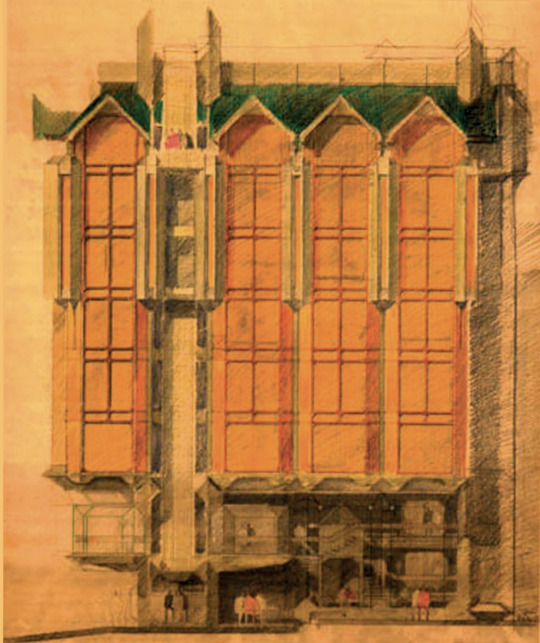
Juvela Office Building in Belgrade (1972).

Tomb of war orphans in Konarevo near Kraljevo (1985).
The final phase of Spasoje Krunić’s adulthood begins in 1995 when he carried out his design of the Office Building in Knez Mihailova Street in Belgrade (1990-1995) and Zora Palace in Belgrade (1994-2005) when he formally began his successful academic career. In the same period, he bravely decided to become actively involved in the political life of Serbia in order to help the country get back on the right track it had diverted from in the 1990s.

Even though his formal academic career has begun relatively late, there are few who could pride themselves on academic successes which he achieved. Spasoje Krunić, like hardly anyone else, has manifested exceptional dedication and loyalty to the Faculty of Architecture in Belgrade ever since he was a student, thus leaving his undoubtedly positive mark on the University of Belgrade as a legacy for generations to come.

The model of primary construction form for the village for refugees shared for the time of crisis in 2015.
As the president of the Belgrade City Government, he attempted to organize and restore Belgrade after years of neglect to the extent this was possible at the time. At that point, an ominous fate befell him when NATO forces bombed Belgrade in 1999, so he had to manage organization of the city under war conditions. There is no worse thing that can happen to an architect/creator, I argue here, than destruction of a city and life!
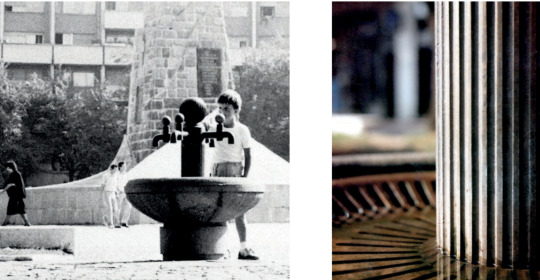
Drinking Fountain in Kraljevo (water is life!) (1982).
At the turn of the century, Spasoje Krunić added two more gems to the treasury of human history: first, the internationally famous Memorial Ravna Gora (1998-2000), where he experimented with minimalism in an expressive landscape, and Motel Koral in Arilje (2003-2012), where he goes back to (romantic) expressionism, thus confirming his authenticity that he has skillfully built and developed since his youth. In my opinion, special attention in Spasoje Krunić’s oeuvre should be given to his metaphors from sacred architecture and primarily his drawings.
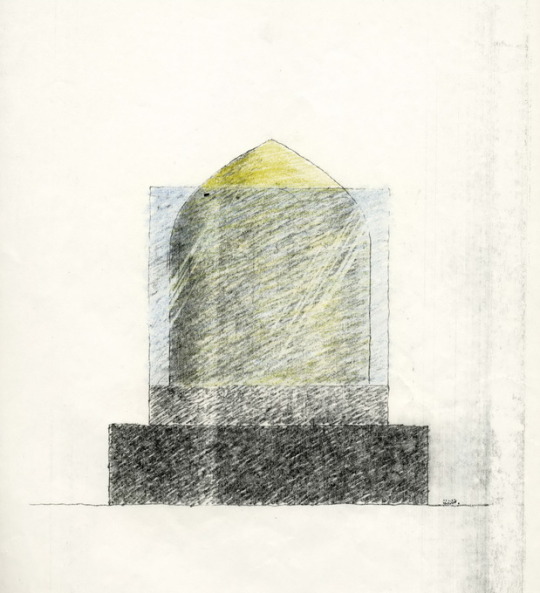
These metaphors tell us mostly about his relationship to the world and life, emanating modesty and restraint, a kind of nobility and humanity, leaving behind only indifference to differences – pure truth. Thus he uses, in the same remarkable way, my favourite metaphor of the Great mosque in Baghdad - First Prize on international competition (1989), and the metaphor of the temple of Christ the Saviour in Priština (1991-1999- ), where works were suspended after Serbia had lost jurisdiction over Kosovo and Metohija.
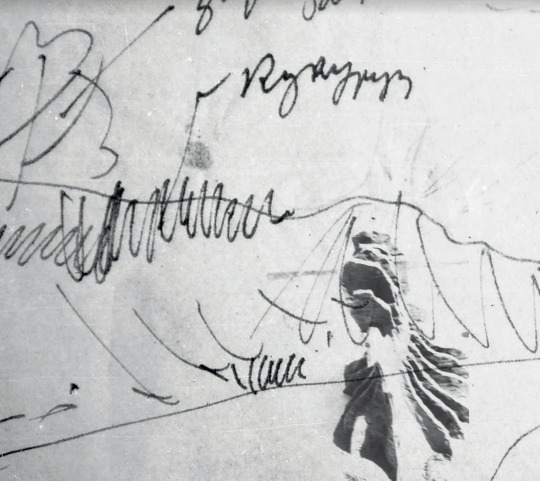
Spasoje Krunić never stopped working on what has not been completed, because his discipline, dedication and ethics did not allow. Indeed, as a dedicated modernist oriented towards a revolution in thinking, he has always been free-for-something, knowing that it is the only way to be free-from-something, which gave him, over and over again, the possibilityand motivation to continue down the road that few people would dare to take.
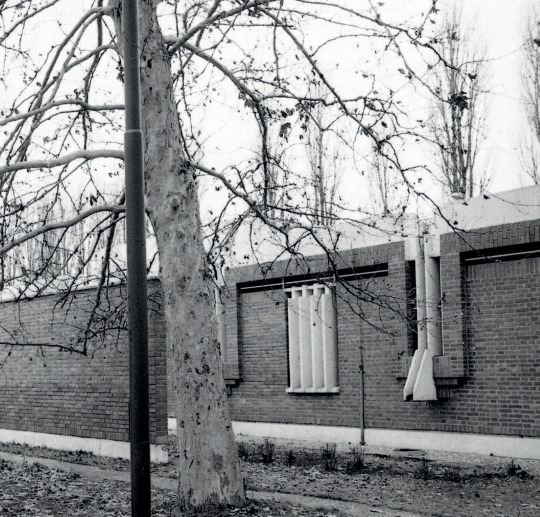
Prison for Foreigners in Belgrade (1983).
The worlds of Spasoje Krunić’s metaphors, in my view, demonstrate this profoundly and prove him to be an accomplished creator of pure thought. These and such worlds are nothing but infinite relations of elements of his personal world with the elements of identity groups he has been involved in, and above all with the elements of the world of history of humanity, nature and the universe.
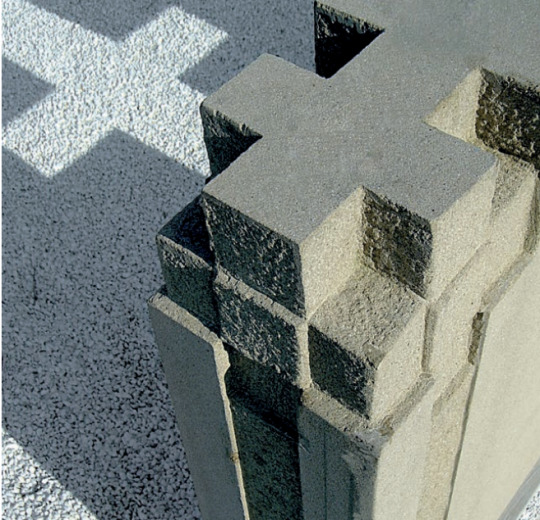
Popović Tombstone (2003).
I know very well that the question of immortality of a human being is something beyond nihilism and sacrifice, and that it is promised only to those who think and act positively, in a word – to creators. Spasoje Krunić was undoubtedly one of the major creators who enriched the world of human history and the world of architecture. His combative and uncompromising defence of the world of architecture and his commitment to affirmative dialectics never cease to amaze me.

---
by Aleksandar Bobić On Metaphors of Architect Spasoje Krunić from the afterward of the book "Spasoje Krunić: Spatial Metaphors" (2017)
56 notes
·
View notes
Quote
Hotch, a tribal leader, lives in Klukwan, a village that takes its name from the Tlingit phrase “Tlakw Aan” – “the village that has always been”. It is the hub of an ancient trading route – later known as the Dalton Trail – that runs from Haines to Fort Selkirk in Canada.
Here in south-east Alaska, the consequences of the climate crisis are already visible. “Our mountains used to be snow-capped all year round,” Hotch said. “Two summers ago, our mountains were almost totally bare.” In Haines, hardware stores sold out of box fans because it was so hot.
King salmon – also known as Chinook – are in particular trouble. Haines’ popular annual fishing derby for largest species of Pacific salmon has been canceled, and now if anyone catches one, it must be released, in the hopes of encouraging their numbers.
“We need the snow to keep water cold for the salmon, for the summer blueberries,” says Hotch. Last year he saw fewer bumblebees, essential for pollination, and the blueberry crop was very disappointing. “I saw a bumblebee last week and I got real happy,” he laughs.
The mine, known as the Palmer Project, is still in the exploratory stage but financial control of the project was taken over by Dowa – a metals manufacturer and one of Japan’s largest companies – in a move that is seen as giving fresh impetus to the project.
If it gets approved, Hotch worries that contamination from the mine, located under the Saksaia glacier, could destroy the salmon runs they rely on. Even the exploration now under way could irreparably damage the fragile ecosystem, he believes, adding that the town would suffer too. Haines is heavily reliant on commercial salmon fishing, as well as tourism – each November, visitors flock to town to watch the largest convocation of bald eagles on the planet gorge on salmon.
“This project is a serious, significant threat facing our people,” says Hotch. “Some of the younger generation here now, they could say, ‘We were the last ones that were able to smoke fish, jar fish, pick blueberries,’” says Hotch. “We are working very hard to make sure no generation will have to say that.”
A tiny Alaska town is split over a gold mine. At stake is a way of life | Alaska | The Guardian
1 note
·
View note
Text
Here’s a rough playlist for driving through California at the end of the decade. California through the eyes of a transplant, giddy with a gauche joy; California burning, vivid in its early autumnal glory, on the verge of climate collapse; California on a sultry, dusty ride that brought us to Tahoe, blue beyond belief.
It’s hard to explain the contradictions that arise when you haven’t lived in a place for very long. You’re overwhelmed by its sharp and cruel beauty- you’re a ridiculous transplant, who hasn’t earned the right to call it home quite yet and is prone to exaggeration and superlatives. I’m not sure when we earn the right to stamp a mark of authenticity to our descriptions. Years of living through droughts and failed rent control measures, where we were when that earthquake hit. It’s overwhelming thinking about what growing up in an entirely different place looks like and who you’d be as a result of that upbringing. Having deep rooted ties to an area, knowing the backroads and when they’re safe to drive in the winter or spring. Is the cost of that knowledge the right to call a place home? A few years ago, I could dredge up some theories on place and belonging, tack on some poetic words to talk about why I feel so awed by this land. Now I just drive and gawk and listen to someone else talk about their feelings.
I hoard feelings about places like antique coins. During conversations, someone mentions growing up in Renton and I run to the map and pore over its proximity to other cities. A suburb of Seattle, home to several large industries. Smyrna, Georgia is the childhood home of Julia Roberts. Penzey’s Spices started in Milwaukee, Wisconsin. I asked my colleague once what it was like growing up in a small town in Wisconsin and she seemed startled, a little confused at what I was looking for. “What do you mean? It was normal. Just like growing up in any other place.” I’m not sure what I wanted to hear either: maybe I wanted the quaint details, the facts of living that are normal to us but not to others who haven’t lived in the same place for their entire lives. I knew it was more complicated than town mouse asking for details about provincial living from country mouse. Maybe it’s a sense of belonging that I’m on the prowl for, so I can experience it vicariously for a short amount of time. A Yankee Candle of belonging that I can sniff and for a brief second, jump into someone else’s place, clad in plaid and all. But of course it’s only ever temporary- I’m not foolish enough to think that a few descriptions can sum up an entire lifetime's worth of belonging.
In retrospect, Steinbeck’s East of Eden, so dry at first, now seems like a worthy endeavor. He wanted to do justice to the area he grew up in: he wanted it to attain legendary status, perhaps the most benevolent attitude we can have to our homes. On our way down to the coast, we stopped in Salinas because I was excited to see Steinbeck’s town. We parked in front of a Denny’s across the street from a gas station. The air was murky with smoke and smelled faintly of manure. We hopped back in and continued our drive down the coast to Monterey and then on to San Diego.
I can’t remember where I read this but I recall Louise Gluck not being able to write until she began working again at a college in Vermont. I feel most alive when I’m moving, traveling from place to place, soaking up everything I can. I go out of my way to talk to people, especially locals, when they’re willing to talk to out of towners. My favorite question is asking them how the area has changed over the years- it usually develops into an impassioned conversation and an indictment of the political landscape. I let them ramble on about the hideous traffic, the failing public schools, the housing crisis, their favorite clam chowder spot. On a boat in Lake Tahoe, I struck up a conversation with the captain. He seemed startled when I asked him about the hazy horizon and then he relaxed and pointed out how the wind had shifted, bringing the smoke downwards from the fires north of the lake. The boat soon docked, since visibility was steadily decreasing. The captain wrapped up our conversation and wished me well on our journey back to the Bay.
There is something about living in a place that’s been dreamt of and written about so frequently. But as our favorite ultra dramatic, overexposed prom queen of California sums up: “So I moved to California, but it's just a state of mind It turns out everywhere you go, you take yourself, that's not a lie.” We listened to Norman Fucking Rockwell on our way to LA, because it’s such a delicious cliche and I wanted to revel in my tinted sunglasses. From Tahoe to the Bay, as we passed burned forests and ashened roads, we listened to Vampire Weekend. In San Diego, we drove back and forth from the hospital and clinics with Imploding the Mirage playing on in the background.
8 notes
·
View notes
Text
big, big fan. cannot overstate my love of crocodiles. always fascinated by historical records of sacred crocodiles swimming in isolated oasis pools among sand dunes in the Sahara, American crocodiles in the Rio Yaqui and Sonoran Desert coast, Cuban crocodiles living in the Bahamas until European colonization, now-extinct terrestrial crocodiles occasionally climbing trees and surviving on Fiji into recent centuries, and saltwater crocodiles traveling the sea to reach the Seychelles and islands in Polynesia.
crocodiles are charming. have always revered them. “nothing scary about them, if you’re very careful.” but once, lucky (privileged) enough to stumble into a discounted travel arrangement, i went strolling. Kakadu. the saltwater crocodiles were clearly visible hanging out on the riverbank, so i went walking in the other direction, away into the woodland. “no danger up here away from the water.” rounded a rock outcrop where a stagnant oxbow pond sat, a remnant from seasonal flooding, and a 3- or 4-meter crocodile wallowing in mud. lunged in my direction. “woah, a little frightening, but very cool. doubt this will lead to residual psychological haunting, no nightmares about crocodiles.”
later, in 2010, the BP oil spill was happening. almost 5 million barrels of oil spilled across over 150,000 square kilometers of the Gulf of Mexico, and a universal weaponized shorthand talking-point reference in “climate crisis” and corporate oligarchy disk horse. aftermath of Katrina still fresh in mind, environmental racism of petrochemical industrial corridor of Baton Rouge and New Orleans complicated by further houselessness and infrastructure failures. one early-summer night, fell asleep on a couch listening to John Williams’s score for that wildly-popular 1993 dinosaur movie (first CD i ever bought for myself), left on repeat. one of the most vivid dreams i ever had.
dystopian near-future hellscape of fractured nation-states under control of Silicon Valley and their surveillance apparatus. basic cliched stuff. collaborating with the rebellious saboteurs, i was dispatched to the network of offshore oil platforms in the Gulf. the mission: idk, stereotypical “dismantle the infrastructure.” a sense of extreme urgency. a clock was counting down, of course. classic anxiety-dream: how much time is left? flames and explosions. natural gas is being burned. a black sky. thunder and lightning, there’s a storm, an approaching cyclone, why not? must escape the drilling platform. the oil company’s mercenaries are running amok, chasing me. i am sprinting across a metal walkway between two platforms, a walkway elevated just above the sea’s churning surface, waves reaching for my feet. i am sprinting to reach, like, a speedboat for dramatic last-minute escape or something. and there are crocodiles everywhere. they initially lunge at me. frightening. but i recognize: they are not malicious. oh, look now: they’re lunging at the corporate private-military villains. i am being rescued by the crocodiles. we are allies, co-conspirators, friends. felt like a resolution to anxiety about crocodiles: no longer lurking beneath the water’s surface. seems like a silly, goofy, idealistic dream in retrospect.
“we are being hunted by human agents, haunted by unjust human institutions, not reptiles.” still. a nightmare converted into an optimistic dream, thanks to the crocodiles. woke up in a sweat, late for work, but unusually contented.
17 notes
·
View notes